

Must Have Trips Passing Concepts in the Spread Offense
Trips is a great formation to get into because it can lead to advantages in the box for the run game and it can clearly define the space that needs to be attacked in the pass game. I personally like trips formation because we tag our quick pass game to our run game on almost every single play, and because of trips we are able to put the ball where we have a numbers advantage.
When we face 2-hi defenses against our trips, I usually aim to attack the flat space in our quick pass game with bubbles, quicks, stick routes etc. because our 3 receivers have 2 immediate threats on defense (CB & OLB). Clearly, these numbers favor us on offense and is space that needs to be exploited.
In this article, I’m going to share a few trips passing concepts that will cause serious confusion for the defense and give you the advantage you need to win through the air.
Trips Passing Concepts
Smash drive concept.
Smash + Drive is a trips passing concept that is a personal favorite because it has answers for multiple coverages.
Typically, the trips are to the field and to the boundary will be a single WR in a nasty split, or an attached TE. The smash concept will be ran to the single WR side. The single receiver will run the corner and the running back will be on an arrow route into the flat. The smash to the boundary can hit successfully against teams that put the nickel to the trips and play cover 2 or 1 to the boundary.
The drive concept comes from the field with the #3 WR running a deep dig at 10 or 12 yards and a shallow cross from the #2 WR.
#1 WR can run a variety of different routes but some of the most common routes are a slant behind the dig or a 5 yard in route.

Here’s a clip of Tulane running the drive smash concept
The QB’s eyes immediately go to the boundary. The CB is pressed to the outside on the #1 WR running the corner (pre-snap read should eliminate the corner route based on leverage), so QB is anticipating the arrow out of the backfield.
With the LB expanding and covering the back into the flat, the QB then progresses to the middle of the field on the drive. The shallow cross comes across nicely under the LB that is getting depth in his drop and the ball is out for a nice completion and gain.
Here’s another example of the concept from Penn State running it with an attached TE
This is a simple read for a QB as the smash concept puts a nice hi/low on the CB to the boundary. Pre-snap read indicates that both routes are available as the nickel is to the field with a 2 high safety look.
The safety is inside on the attached TE which leaves uncapped, or open space for the corner on the break point. This is where the hi/low comes in as the QB will get his eyes on the CB and essentially throw it to where he’s not, or into the open space.
The CB immediately pedals into his zone and stays over the top and outside of the corner, so the QB plants on his 3rd step and throws the ball to the RB into the flat. A simple throw and catch leads to a 6 yard gain for Penn State.
Follow Concept
The follow concept out of trips is usually when one receiver is running a shallow which is “followed” by another receiver running some sort of an angle route behind it.
This concept is a good zone beater and man beater, especially against man defenses that want to “banjo” or switch responsibilities when receivers cross each other off the LOS.
Below is a diagram of how Jackson State ran their follow concept in 2022.

Here’s a clip of Jackson State running this trips passing concept.
In the concept from Jackson State, they use the #3 WR to run vertical at the OLB to threaten him vertically causing him to get depth at the snap of the ball. This movement is intended to occupy him for a split second for the 2nd shallow or angle route coming from the #1 receiver to slice in front of his face.
The #2 WR is running the first shallow cross in the concept and his job is to occupy the ILB by sitting down in the zone forcing the LB to attach to the route. This will occupy the ILB so he cannot expand and threaten the #1 WR who is following the route.
The #1 WR has to let the concept develop off the LOS for a split second with the vertical release by 3, and the shallow cross by 2. This is why he foot fires off the line of scrimmage before breaking in on his route.
The QB’s pre-snap read indicates zone coverage, and he’s anticipating throwing the follow route immediately out of the break. The QB knows the first crosser will occupy the ILB and the vertical will push the OLB just enough for the #1 WR to break underneath it. With great timing on the throw, #1 WR catches the ball immediately out of his break and is able to make a move for a 7 yard gain.
In the next diagram the follow concept comes from North Carolina who runs it differently than Jackson State, but accomplishes the same goal.

I like this follow concept because it’s ran out of a compressed bunch set with cross action off the line of scrimmage from all three receivers.
The movement off the line of scrimmage from the bunch set creates confusion as the defense finds itself out of alignment and exposed for a big gain.
Here’s the clip of North Carolina running the follow concept from a compressed bunch look.
The #2 on the LOS does a great job clearing out the OLB with his wheel route. The outside release on the wheel causes the OLB to widen and get depth.
The #1 immediately crosses underneath the wheel route with the ILB in his sight. His job is the same as before which is to occupy the first inside backer. In this example, the ILB not only attaches to him, but abandons his zone responsibilities and runs with him across the field.
The #3 WR allows the wheel and cross to develop by getting width at the snap of the ball. As the OLB maintains outside leverage because of the release on the wheel, the angle route cuts inside with a massive window for the QB to throw into.
Ultimately the QB is progressing through two routes, the first cross and then the follow. QB’s eyes immediately go to the first cross and he sees the LB attach. He then progresses to the angle follow and it’s a simple throw and catch from there for a huge gain. The QB does have a pre-snap alert to throw the Go route with the single WR, but the CB and Safety help to the boundary would make for a tough throw.
It’s important to note that the key to making this play happen is the wheel route by the point man in the bunch look. This player has to understand that his route is ultimately dead from the beginning and he’s sacrificing himself in order to move the OLB just enough for the angle route to open up inside. It doesn’t count as a catch in the box score but this is just as important and his teammates should be giving him props for setting them up for success.
Post Wheel can be ran a few different ways out of trips, but the way Western Kentucky ran their post wheel concept in 2021 really caught my attention. Below is a diagram of how WKU ran post wheel out of their trips formation.

What I like about the way WKU ran their post-wheel is how they used their strength in their screen game to set up the wheel route. In this trips formation set, WKU runs Post from the outside, flashes tunnel screen from the #2 WR with the #3 WR stalking the OLB before releasing on the wheel route.
Here’s the clip of WKU running post wheel
The defense has a man advantage over the trips as they walk LB out to get 4 defenders over the 3 WR’s with Safety help over the top. It appears the the defense might be playing 2-man which leaves a huge mismatch on the #3 WR and the LB.
The outside WR runs his post and the CB absorbs the post route.
The #2 and #3 make it look like they are running one of their successful tunnel screens. #2 flashes out on bubble before replacing #3 down the LOS. This triggers the OLB to get down hill and into the flat to break up what he thinks is a screen pass.
The QB does a great job recognizing the CB running with the post and gets a firm ball out on a wheel.
If you’re familiar Air Raid pass concepts then you may have heard of the China concept out of trips. The #3 will run a corner while #2 and #1 both run 5 yard in routes. It’s a great concept against multiple coverages whether it’s zone or man. Typically this concept is to attack space behind the CB with the corner route, or underneath with horizontal conflict on the OLB with the two 5 yard in routes.
Ohio State’s version of the China concept is using the #2 WR on a double move. He hits the top of his break point at 5 yards like he normally would on his in route, but now he stutters and attacks the open grass in the middle of the field.
Here’s how it’s drawn up:

The QB should be licking his chops before the ball is snapped as he sees the Free Safety outside shade of the #3 WR. This should indicate that he has the green light on the stutter go. The play action holds down the only linebacker in the box long enough and the QB throws a good ball over the middle with pressure in his face.
Here’s a clip of WKU running the China Go concept:
In this look, the defense put numbers to the field with 4 defenders over the 3 WR’s. Looking at this defense It appears they are playing stress coverage / 3 match as the Mike and Free Safety are taking all of #3 vertical. As the #3 runs his corner route, it clears open the middle of the field for the #2 WR to attack open grass.
This is a great concept for defenses that play MOFO without any help from the backside safety.
Double Corner Switch
When I first saw Ohio State run this concept in 2019, I had to watch it at least a dozen times. Every time I played the clip back I just kept thinking how impossible it is for a defense to cover it correctly.
Below is how Ohio State ran their Double Corner Switch concept

The defense is also adding numbers to the trips formation with 4 defenders over the top of 3 WR’s. The QB has a MOFO look pre-snap with plenty of open grass for the taking on the switch vertical by the #1 WR in the trips formation.
Here’s a clip of Ohio State running Double Corner Switch
The Corner route by the #3 WR is a high angle corner whereas the #2 WR runs more of a low angle, or flat corner route.
Regardless of what coverage the defense is in, and how they move their safeties post-snap, the look of MOFO is still the same. The LB’s in the box have no chance of carrying this vertical coming from the wide side of the field by the #1 WR.
The QB initially gets his eyes to the left side of the field and quickly works back to the wide side of the field as he sees the boundary safety roll down after the ball is snapped.
The vertical is able to get on top of the LB’s with his man chasing him in a trail technique. It’s a great ball by the QB, but more importantly great patience to let the WR clear the inside linebackers and get vertical before throwing a strike for a touchdown.
Benefits of Trips Passing Concepts
You can clearly see how operating out of trips can be beneficial to an offense. It opens up a number of options in the run game or pass game. This article touched on just on a few drop back passes, but there are several quick game concepts and screens that can be highly effective out of trips formation.
The other added benefit to operating out of trips formation is how your WR’s will align in the set. Whether it’s bunch, stack, or compressed you can really manipulate a defense and the space you want to attack based on your alignment.
Ultimately, trips formation and trips passing concepts are extremely difficult to defend. Every offense should develop their package of trips passing concepts for a more successful pass game.
Advertisement
The best route combination for every type of coverage, share this article.
Last week the Sports Info Solutions Data Challenge came to its conclusion, as the judging portion of the competition took place on Wednesday night. The challenge tasked teams with taking a dataset of play-by-play data provided by SIS and answering two questions. First, what was the most popular route combination in the NFL last season? Second, what was the most successful route combination in the NFL last season against each type of coverage?
I was lucky enough to pair up with a brilliant team. Before going any further, I strongly recommend that you follow all three: Dr. Bud Davis , Keegan Abdoo and Joey Ferraiola . They’re brilliant, and approximately 98% of what follows is due to their work.
For those interested, you can view the judging portion of the finals here:
But I thought it might be interesting to look at the findings with respect to the second prompt: Which route combinations work best against each coverage. What follows is a discussion of the methodology our group used to answer this question, our findings for each coverage and film examples to illustrate the concepts.
Methodology

Before diving into the data a few words on the methodology. To begin, we built a “route concept dictionary.” This was based on playbook study and analysis, and eventually included 36 different route concepts, some of which you can see above. This dictionary enabled us to perform a first-pass identification of each of the route concepts on the plays provided.
On the first-pass, we were able to identify route concepts for 11,580 plays of the data set. However, that left 4,768 plays, or approximately 30% of the snaps, unidentified.
This is where the fun began.
Dr. Davis then constructed a Convolution Neural Network. This model used machine learning to identify route concepts within the plays provided:

The way this worked was by looking at each route concept, building a graphical representation of the route, and then comparing it to other route combinations and offering anywhere from one to three possibilities for the route concept identification. Here are some examples of how the CNN model identified routes that the route dictionary failed to uncover:

This method got us much closer to the full identification, although there were some errors. Most errors were either false positives — wherein a route concept identified was not labeled by the route concept dictionary — or false negatives — wherein the CNN failed to identify the route concept. Still, we were much closer to identifying all the plays, so it was time for some analysis.
That led us to this grid of each concept versus the charted coverage data, in terms of Expected Points Added per play:

Before diving in further, a word on sample sizes. There was not a ton of data to really go with here. Some plays were executed against a given concept just a handful of times, as such we excluded instances with less than 25 occurrences for sample-size issues. So some of the pairings you will see happened just 25 times last season, which is interesting, but likely not enough data to form concrete, definitive conclusions. But in the next few seasons I will be paying close attention to these pairings.
Cover 0: Y-Cross

(Denny Medley-USA TODAY Sports)
As you can see from the above diagram, the most successful concept against Cover 0 was Y-Cross.
Now, this also needs further context. In our sample size Y-Cross was defined as an inside receiver running the crossing route over the middle. This was our only single-receiver concept, which in part led to this design being the most frequently observed concept out of all the plays examined.
Given that context, however, the Y-Cross came up as the most successful route combination. This example, tagged in our analysis as Y-Cross and charted as a Cover 0 play by SIS, provides some reasoning:
As you can see, Cover 0 is often a blitz package, with the defense sending pressure and playing man across the board in the secondary with no safety help. That is exactly what plays out here, with the New York Giants sending pressure after Ben Roethlisberger and playing without safety help in the secondary, and using man coverage across the board.
JuJu Smith- Schuster runs the crossing route — leading to the Y-Cross tag in our analysis — and without safety help in the middle of the field, he simply crosses the face of the man defender. Then you see a scenario play out: “If you play Cover 0 and you don’t get home, the other band is going to play.” Rod Gilmore said that in the booth once, and that has stuck with me. The Giants do not get to the QB, and Roethlisberger finds Smith-Schuster for the TD.
Cover 1: Drive

(Geoff Burke-USA TODAY Sports)
Next we look at Cover 1, which combines man coverage across the board with a free safety in the middle of the field. Our analysis found that against Cover 1, the most successful route combination was the Drive concept, which by our definition pairs a dig route from an inside receiver with a shallow crossing route from the outside receiver.
Here is an example of Drive run against Cover 1, thanks to the Seattle Seahawks:
On this play the Seahawks use pre-snap motion to help identify the coverage, as Tyler Lockett motions in towards the middle of the field, and then back to the outside. The cornerback trails him the whole way, so Russell Wilson knows man coverage is in play. Lockett then runs the shallow while tight end Greg Olsen runs the dig. Because Wilson knows it is man coverage, and the release of the tight end helps create some traffic, Lockett is open on the shallow route for a gain of five.
Cover 2: Diagonal Nine

(Joe Nicholson-USA TODAY Sports)
Next up is Cover 2. Before diving into Diagonal Nine, and why that might have been an easy choice before seeing the data, another word on methodology. As touched upon in an earlier image, we grouped vertical routes such as “out and up,” “fade,” and “chip-seam” all under the bigger umbrella of “vertical routes.” The reason being that all routes that ended up attacking vertically stressed the same areas of the field, and that would give us a wider look at concepts rather than narrowing things down.
But we found that Diagonal Nine, which pairs a go route from an outside receiver with a route to the flat from an inside receiver, was the most successful against Cover 2. Here is an example from the Seahawks against the New York Giants, and keep that methodology in mind as you watch this clip, a play identified as both Diagonal Nine and Cover 2 in the dataset:
You can probably see why I put the caveat about the methodology at the start.
On this play Lockett runs an out-and-up, which gets tagged as a vertical route in our database. Running back Chris Carson chips and then releases to the flat, and that combination led the CNN model to identify this play as a Diagonal Nine, with Lockett on the vertical and Carson into the flat.
Still, the reason why Diagonal Nine (or Go/Flat in other systems) is a stress for Cover 2 is on display here. The go route attacks the soft spot of Cover 2, the “turkey hole” deep along the sideline. The flat route works to hold the cornerback in place, expanding the window. The safety has to race to the sideline to make a play on the football. Complicating matters here is the fact that Seattle runs this otu of a three-receiver set, and D.K. Metcalf is running a post route from the outside alignment. That puts the safety to that side in a bind: Buzz outside for Lockett and you expose the post. Stay home and stick on the post, and you expose the vertical.
Here, the safety tries to read Wilson and react. He gets there too late to prevent the completion.
Another reason why this is the most dangerous combination against Cover 2 is this: Think of all the different ways defenses try and stop Diagonal Nine/Go Flat from Cover 2 looks. Teams can run Palms or 2-Trap, where the cornerback reads the break of the inside receiver and if he sees that player break to the flat, he will peel off the vertical release and “trap” the flat route. Another viscous coverage is something termed 5 Cougar, where the cornerback actually executes a man coverage turn, showing the quarterback his back as he breaks with the vertical. But the cornerback is still reading the break of the slot receiver, and if he breaks out, he’ll bail off the vertical and trap the flat route. (For a deep dive into this I wrote about that coverage two summers ago):
If defenses are tweaking a coverage because of what a specific route combination can do against it, you’re probably right in thinking that combination works against the base coverage.
Cover 2 Man Underneath: Verticals

(Gary A. Vasquez-USA TODAY Sports)
Speaking of Cover 2 variations, we come to Cover 2 Man Under, which retains the two-deep safety structure over the top of the defense, but utilizes man coverage underneath. In terms of context it is important to remember, as coach Rick Neuheisel pointed out as one of the judges, that this coverage is often used in third-and-long situations. Downs and distances where the deck is already stacked against the defense. That illustrates in part why Cover 2 Man Under was the most successful coverage out of any in the data set.
But the play that works against it the best, in our study, was Verticals. The reasoning is similar to the previous analysis of Cover 2, in that the outside vertical route has t he chance to threaten the weak spot of the coverage, that “turkey hole.” In addition, Verticals against Cover 2 Man Under also finds an inside vertical route attacking the hole in the
middle of the field between the safeties, with a receiver working against a man coverage defender. If that receiver can get a step on that defender, he should find space to work in the middle of the field.
That is exactly what happens here, as Gardner Minshew hits his tight end for a touchdown against Cover 2 Man Under:
Tampa 2: Portland

(Photo by Ethan Miller/Getty Images)
Next up is Tampa 2, another member of the Cover 2 family that tasks a defender, often a linebacker, to be the “middle field runner.” He will drop deep to help the safeties by dropping into the middle, helping protect the soft spot between them.
The route concept that we found works best against Tampa 2 is what we termed Portland, which has a post route from one side of the field with a crossing route from the other. This could also be referred to as the Yankee concept. Whether Portland or Yankee, this is usually a play called out of a heavy formation and off of play-action, looking to hit the defense deep.
On this example the Las Vegas Raiders call Portland on a 2nd-and-7 situation against the Tampa Bay Buccaneers out of 21 offensive personnel. The Buccaneers have a base 3-4 defense in the game. You will see linebacker Devin White drop deep with the post route from Henry Ruggs III, and that creates space — along with the run fake — for the crosser to Nelson Agholor:
Whether Portland or Yankee, this design is often thought of as a single-high beater, as it puts the post safety in a box. He either drops to take away the post, and crashes down on the crosser, opening up an option for the QB. That has led to a defensive adjustment where the safety is free to “cut” or “nail down” on the crosser and the cornerback peels off the man running the crosser and replaces him in the middle of the field.
But as the data showed up, as well as this clip, when run off play-action and in favorable situations, you can execute this design against Tampa 2.
Cover 3: Spacing

(AP Photo/Mark Tenally)
Boring, I know.
One of the more intriguing findings in our study was the idea of “Explosive” versus what we termed “On Schedule” plays. We found that there was a tradeoff between how frequently a route generates a positive EPA, and the magnitude of that EPA. That led us to two different buckets of route combinations: “Explosive” and “On Schedule.”
Explosive route combinations were not successful as often, but when they hit, they hit big. Think aggressive, downfield shot plays like Verticals, Dagger and Mills.
Then there are the On Schedule plays, that might not hit for huge yardage, but they were successful far more frequently. Those are your typical West Coast designs like Stick, Outs, Curl/Flat and the like. Those are plays you might call to start a drive, to get your QB in rhythm, or to move the chains on 3rd-and-4 or so.
One of the more interesting findings, at least in my mind, was that Spacing was a more explosive play than you might expect. Below is our graphic showing “Explosiveness” versus “Consistency” by concept, and the upper left quadrant shows the more explosive plays. Amidst the aggressive shot plays like Dagger and Mills and Verticals, you see Spacing, a concept with a cluster of short routes designed for easy reads and throws:

Additionally, we found that this design was the most successful against Cover 3. And it might make a bit of sense. After all, Spacing tasks recivers with sitting down in soft spots against zone coverage, and Cover 3 does offer a lot of those underneath. If you make a quick read and throw, that can offer the potential for yardage after the catch, turning a quick throw into an explosive play.
Here is a play identified in our study as a Spacing concept against a coverage charted by SIS as Cover 3:
You can see how this design works against Cover 3, and has the potential to turn into a big play. The quick throw puts the receiver in position for YAC, and the route design works to find holes against the underneath coverage early in the down. Usually good things for the offense.
Cover 4: Cab

(Bob Donnan-USA TODAY Sports)
The next coverage and route combination to discuss is Cover 4, and the Cab concept. We defined Cab as a route with an outside receiver running a dig, and the inside receiver running a shallow crosser. You can find the graphic in the upper right of the earlier image showing all the route combinations.
Here is an example of this concept in action against a play charted as Cover 4 in the dataset by SIS:
Now, a few words on this pairing. One of the potential limitations to our study is that we did not isolate the EPA added on a play by the route targeted. That leads to situations where, as is often the case, you might have two different route concepts on a given play, but both concepts get credit for the EPA added. So, for example, say you have an aggressive vertical concept like Diagonal Nine called to one side of the field, but Curls or Spacing to the other. If the defense drops into Cover 3 the QB might look to the Curls or Spacing concept, but both concepts get credit for the resulting EPA. On a good number of the Cab against Cover 4 examples, the QB ended up throwing elsewhere. Something to keep in mind for future study.
On this particular play, however, Teddy Bridgewater has both the crossers open, due in part to the structure of the coverage, as well as the vertical release from the inside receiver which draws the attention of the underneath defenders for a moment. That opens up Robby Anderson on his shallow crosser.
Cover 6: Shallow Cross

Our last pairing involves Cover 6, and the route combination we found most successful against this design was Shallow Cross, which pairs a dig route from one side of the field with a crossing route underneath it, just past the line of scrimmage.
Here is an example of that pairing, with the Los Angeles Rams running the Shallow Cross concept against the San Francisco 49ers:
On this play Josh Reynolds runs the shallow crosser underneath while Cooper Kupp runs the deeper dig from the opposite side of the field. San Francisco drops into the Cover 6 look, and Jared Goff takes the easy read and throw to Reynolds on the shallow, in front of the linebackers.
You can see how conceptually this design might work against this coverage, as it puts the underneath defenders in a bind between dropping under the dig or collapsing on the shallow. But that is a situation encountered with most zone coverages, so I would caution readers not to take this as gospel truth. Something tells me there might be a bit of a sample-size issue with this coverage and route combination pairing.
Want the latest news and insights on your favorite team?
Sign up for our newsletter to get updates to your inbox, and also receive offers from us, our affiliates and partners. By signing up you agree to our Privacy Policy
An error has occured
Please re-enter your email address.
Thanks for signing up!
You'll now receive the top Touchdown Wire stories each day directly in your inbox.
Most Popular
2024 nfl mock draft: qbs go 1-2-3, dak prescott to broncos in new two-round projections, 2024 nfl draft big board: the 50 best prospects, no. 1-25, 2024 nfl draft big board: the 50 best prospects, no. 26-50, the best pro football player to wear every jersey number, the 101 greatest nicknames in football history, nfl draft: every quarterback who went no. 1 overall since 1967, 2024 nfl mock draft: qbs go 1-2-3-4, trades galore in latest first-round forecast.
Please enter an email address.
Thanks for signing up.
Please check your email for a confirmation.
Something went wrong.
- Football Plays
- Football Strategies
- Madden Tips
- Madden Playbooks
- Madden Guides

Common Pass Routes and Route Combos
In the article we posted on X’s O’s Football called " Passing Routes 101 " we broke down several passing routes for runningback, receivers, and tight ends. For this article we show several common pass routes and route combos that you will find in real football and video game football. We break the sections down with quick pass, medium pass, and deep pass.
A look at common quick pass routes, passing concepts, and route combos.

Medium Pass
A look at common medium pass routes, passing concepts, and route combos.

Double Moves

Shallow Cross

A look at common deep pass routes, passing concepts, and route combos.

The comeback has the receiver taking an outside release and running about 18-20 yards up the field. He then break outside towards the sideline at a 45 degree angle.

The Dagger is a two receiver route combo that has the outside receiver running a dig route, while the inside receiver next to him runs a streak down the seam.

The Divide is a passing route that that has a receiver running towards the middle of the field. The route involves a MOFO or MOFC read by the quarterback. For those that don’t know MOFO simply means "middle of the field open," or no deep middle safety. MOFC means "middle of the field closed," or is there a deep middle guy. Another route is used to compliment the Divide pass route is a receiver on the outside running a go or streak route.

The Double Dig has two receivers running dig routes to the same side of the field. One receiver runs a shorter dig, while other receiver runs a deeper dig.
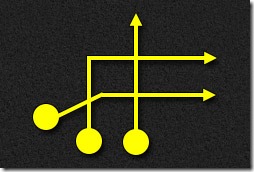
A popular way offenses like to attack zone coverage is flood one side of the field with mutiple receivers. The Flood concept does this by having three receiver running pass routes towards the same of the field. A common Flood concept would be to have one receiver run a flat, second receiver runs a deep out, and the third runs a go route such as shown in the diagram above.
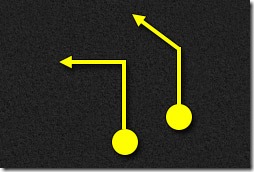
The Mills (Anchor) passing concept is designed to get a to bite on the dig route, allowing for the receiver running the post to get behind him for big play. If the safety does not bite on the dig route, then quarterback would look to throw to that receiver underneath.
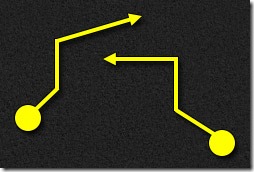
The Portland passing concept is similar to the Mills concept as the design is to provide an opportunity for the quarterback to look throw deep down the field to a receiver running a deep post if the safety comes up defend the dig route that is being run from the opposite side.
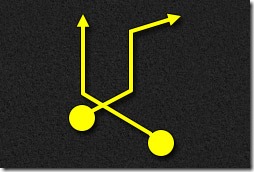
The Switch concept is a popular Run-&-Shoot passing concept that has outside receiver running a post route with an inside receiver. The inside receiver, runs a wheel route down the sideline. By them switching, it creates an opportunity for a big play deep down the field.

The Verticals passing concept sends 3 or 4 receivers on vertical passing routes. The idea behind this passing concept is to create either 3 on 2 or 4 on 3 against zone coverage, allowing for one of the receivers to be open deep down the field.

The Y Cross has the tight end (Y) running an intermediate crossing route. The concept is good versus both man coverage and zone coverage. If man coverage is called, the tight end will generally matched up against slower linebacker or a smaller defensive back. Once gains separation or leverage he is will be open. Against zone coverage, look for the tight end to be open as he crossing the field, especially if another receiver is running pass route underneath or over the top of him.
Final Thoughts
Hopefully this will give you better idea of common pass routes and route combos found in real football and football video games. Feel free to use this page as quick reference if you are confused about these type pass combos, pass concept, and pass routes are designed for.
RELATED ARTICLES MORE FROM AUTHOR
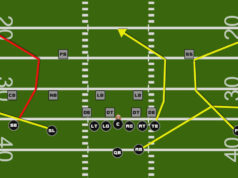
Post Corner High-Low Isolation Vs Cover 2 Zone Coverage
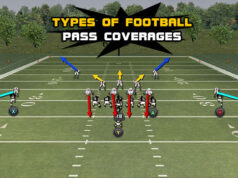
Types of Football Pass Coverages
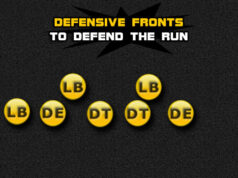
Defensive Fronts to Defend the Run
Who needs this… Football Nerds
Outstanding breakdown. These indeed are the most common route combinations and concepts. They pay Tony Romo about 17 million dollars a year to tell you this on Sunday, and Thursday Nights. Knowledge is power.
Okay but I think Romo may have a bit more knowledge than a few route concepts. He gives us top analysis through his experience of being a franchise quarterback, and happens to be an entertaining voice, name another announcer who can do that. Romo will turn out to be an all time announcer for CBS
LEAVE A REPLY Cancel reply
Save my name, email, and website in this browser for the next time I comment.
MORE MADDEN TIPS
Gun trips te – hb angle, backwards c route, 3-4 bear – pinch 0, the importance of madden sliders.

EVEN MORE NEWS

Gun Bunch Wk – Flood

Gun Doubles HB Strong – Y Cross

Gun Trips Left Hb Strong – S Motion Z Post
Popular category.
- Madden Tips 224
- Football Strategies 100
- Football Plays 77
- Kobra's Corner 26
- Digital Guides 10

Youth Football Online
The Promotion & Instruction of Youth Football
YFO Newsletter Signup
Follow on social media.
- Offensive Line
- Quarterbacks
- Receivers/ Tight-ends
- Running Backs
- Passing Concepts
- Blocking Techniques
- No Huddle Offense
- Defensive Line
- Linebackers
- Defensive Backs
- Pass Coverage
- Kicking / Return Game
- Kicking Technique
- Special Teams Plays
- Offensive Line Drills
- Quarterback Drills
- Running Back Drills
- Wide Receiver Drills
- Defensive Line Drills
- Linebacker Drills
- Defensive Back Drills
- Best Youth Football Plays
- Plays-Offense
- Offensive Systems
- Plays-Blitzes
- Defensive Systems / Blitz Packages
- 7v7 Flag Football
- Youth Football Virtual Clinics
- Speed and Agility Training
- Strength and Conditioning
- Youth Football Training
- Practice Planning
- Football Parents
- Playbook Bundles
- Virtual Clinics
- 10 Best Flag Football Plays | 7on7
Home / Uncategorized / Flood Passing Concepts
Flood Passing Concepts
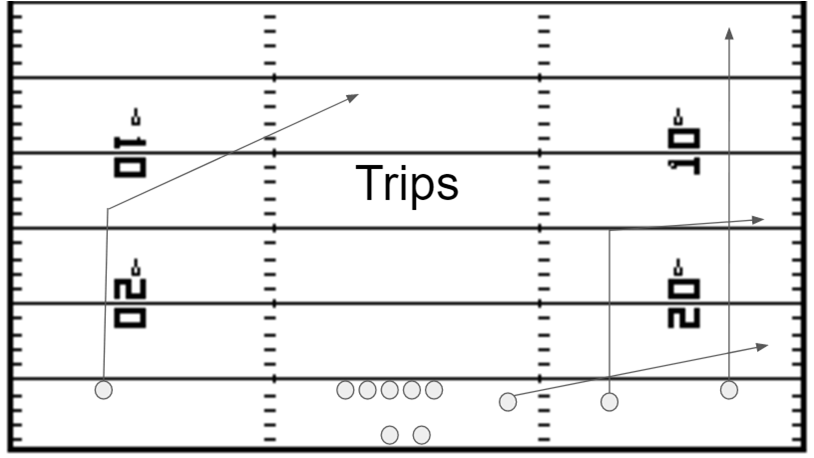
Flood concepts work very well against zone coverage and man to man coverage defenses. They can be ran from a variety of different backfield actions including drop back, play action or roll out. By adding three receivers at different levels all on one side the defense is stressed and a route will come open.
Running the flood off of play-action will put even more pressure on the defense. It will put the defenders in conflict and really mess with their eye discipline.

There are a variety of different ways to distribute routes but the Flood Concept has three different locations where a receiver will end up. The first portion of the route is that there must be a receiver running deep to stretch the coverage. This receiver must force the defense to use a man to cover him deep. While this route is rarely open, by gaining depth and taking a defender out of the coverage he opens the routes up for the other receivers.
The second route is a receiver needs to be 10-12 yards deep along the sideline. This receiver can come from a variety of different positions. This is the route many quarterbacks are taught to look for first. The purpose of the route is that he gets behind the flat defender. In a simple high low concept the deep defender could take him but because of the deep route he now has space to work in behind the flat defender.
The third route is what puts the flat defender in a bind. This is the arrow or flat route that is aiming to get the ball at around 3-5 yards deep. This is route is best when it is run by a player who is dangerous with the ball in open field. The major yards from this play do not come from the catch but from him making a run once he does get the ball.
The majority of times the Flood route is going to be a read on the flat defender. The defender is in a difficult position because he has a route running behind him but he also has a dangerous ball carrier running a flat route directly in front of him. This leaves him with a difficult decision. By rule he should drop to the receiver who is behind him and then come up to make the tackle on the flat route. This is much easier in theory than practice because the flat route is directly in his face. When he jumps the flat route the QB can throw the ball to the uncovered receiver behind him.
If the flat defender does play the route by rule the Quarterback can give the ball to the flat route who is normally a Tight End or Running Back who is now running with a full head of steam which makes for a difficult tackle.
In the event that all of the routes are blocked the Quarterback also has the option, especially on a roll-out, to run the ball. Many defensive coaches are more worried about the Quarterback running it so most of the time there will be someone open.
(See Also) Flood Passing Play

Easy Completions Clinic

Elite Football Playbook Bundle | Best Sellers

Power I Formation Football Clinic

Single Back Formation Clinic 2024

4-4 Stack Defense Playbook
Recent articles.

Contribute Content
All children will learn life lessons from participating in youth football. Join our Movement today.
Returns + Exchanges
Terms and conditions.
YFO Selected as a Hudl Top 100
Youth football parents, yfo all stars.
* indicates required

Copyright ©2023 Youth Football Online. All rights reserved.
Football Toolbox
Three Best Routes to Implement Out of the Trips Formation
September 28, 2017 by
Jeremy Plaa Head Football Coach Thomas Downey High School, Ca.
Coach Plaa begins his presentation talking about Trips Stretch (spacing route) which he runs from trips sets which are 3×1 formations. Coach shares his approach for attacking zone, man, and pressure defenses. Coach discusses how he adds RPO’s to the to the quick passing game and how they are best run from when on the hash. Coach discusses the things that he wants to avoid with his approach which is speed outs instead of square outs, bad rub routes, sit/hole routes to deep, curl routes to shallow, and how the quarterback check across the ball. Coach Plaa provides illustrations with rules and actual game film to support his approach from Trips (3×1) formations.
The video is brought to you by and is a part of the Glazier Drive Coaching Systems. Your growth as a coaching staff shouldn’t be limited to a once a year event or a library of static digital content. That’s why we launched Glazier Drive. Glazier Drive includes: Systems: 22+ complete coaching systems with live Q&A Live Events: Topic-specific deep-dive digital events Video Library: 900+ curated videos Social Platform: Forums, posting, and direct/group messaging Weekly New Content: New videos added almost every business day Start your free trial at GlazierDrive.com .
Please make sure that your sound is on and click on the video to play.
This is a You Tube video, so please make sure that your network allows you to access You Tube.
- Special Teams
- Training & Conditioning
- Intangibles
- Program Building
Cookie banner
We use cookies and other tracking technologies to improve your browsing experience on our site, show personalized content and targeted ads, analyze site traffic, and understand where our audiences come from. To learn more or opt-out, read our Cookie Policy . Please also read our Privacy Notice and Terms of Use , which became effective December 20, 2019.
By choosing I Accept , you consent to our use of cookies and other tracking technologies.

Follow CougCenter online:
- Follow CougCenter on Twitter
- Follow CougCenter on Facebook
Site search
- WSU Cougars Football
- WSU Baseball
- WSU Cougars Basketball
- WSU Football Recruiting
- Air Raid Playbook
- Full Archive
- CougCenter Contest Champions
- CougCenter’s Community Guidelines
- What Is CougCenter?
- Yahoo Washington State Cougars News
- Yahoo Washington State Cougars Team Page
- Yahoo Washington State Cougars Transactions
- Odds & Fantasy
- Community Guidelines
Filed under:
Air Raid Playbook: How to call a play
Names of plays in football can sound like nonsense but really convey a ton of information in the fewest amount of words.
Share this story
- Share this on Facebook
- Share this on Twitter
- Share this on Reddit
- Share All sharing options
Share All sharing options for: Air Raid Playbook: How to call a play
/cdn.vox-cdn.com/uploads/chorus_image/image/9477679/20120929_ter_an2_025.0.jpg)
In the weeks leading up to the Crimson and Gray game, we are presenting an Air Raid playbook series. The hope is that you'll get a better understanding of how the offense works and why it's conceptually able to exploit defenses, and if you're able to apply that to enhance your enjoyment of watching the Cougs, all the better.
If the names of football plays sound a bit like gibberish and you aren't sure what all the words and numbers could mean, this post was written with you in mind.
By understanding what needs to be conveyed in the name of a play, we can peel back the curtain on some of the lingo. Remember, because of the pace of the game the language of a play call is structured to convey the most amount of information in a manner that is the simplest to communicate.
Rather than full sentences, only numbers, letters and coded words relate the who-what-when-where of each play. The structure of a play call is nearly universal throughout football. This is the most efficient way to relate play information -- so much so that high school and even youth football will use this structure. The numbers, letters or words used to relay each bit of information are strung together in this order to call a pass play:
Formation - R/L - Pass Protection (or Play Action) - Motion - Receiver Routes
It should be noted this is not referring to how teams signal in a play from the sideline. Those methods are extremely variable, like 3rd base coach signals in baseball. Those signals can be this information masked in another layer (or two) of code, but more often they simply give the QB a number to look up on his wristband that lists the plays.
There are two prevalent methods used to convey which routes the receivers will run: Passing Tree and Concept.
In a passing tree, each route is assigned a number. Words can also be used to call routes using this method, but this tends to make playcalls very wordy, and too complex for a simple example.
Passing Tree Example
So for a trips (3 X 1) formation, like Early or Late ( read up on formations here if you missed it), a 3-digit code would tell each trips receiver what route to run. These codes can be interpreted a few ways based on a coach's preference. Example; "341" which could be transcribed either -- left to right independent of the side of the ball, always inside-out, always outside-in, or be receiver specific. This example would be read outside-in, giving a "Flood" type pass concept. Below you can see how the routes look from trips to the right or left. A drag or backside post is ran on the opposite side of the trips.
Passing trees allow a great deal of flexibility for the Offensive Coordinator during in-game play calling. An OC could be up in the booth, see what route would work by which receiver and essentially call a tailor-made play. It does, however, require every receiver to learn how to run every route from any position they could be on the field.
The other method, based on pass concepts, is preferred by Coach Leach. A "concept" means the routes are designed to be synergistic. Each route is part of a coordinated effort, they function to maximize open space on the field, attack coverage zones or cross man coverage. Each concept the coach draws up is given its own unique name/number(s)/letter, allowing the communication of every route by a single identifier.
Below is the same play given in our passing tree example, Flood (or Y-Sail in the Air Raid), but the concept is now identified by a single digit, say "5" (double digit numbers could also be used). You have a vertical, corner (or "sail") and flat route to the playside with a drag and backside post. We'll get into Y-Sail more in another post, this is only meant to illustrate how an entire concept is relayed using the two methods.
The Air Raid is unique in its passing concepts;
Mesh, All Curl, Wheel, Sail, Y-Cross, Shallow, Stick, Corner, Shakes, Four Verts.
We aren't sure whether Coach Leach assigns a single or double digit number to each of these concepts, but we do know this is his method. We also do not know with certainty what number corresponds with each concept.
If Coach Leach needs to change one (or more) routes in the concept, those route names would be tacked on to the end of the call by saying "Y-Option" or "F-Shoot" or whatever the specific case may be.
A typical way to denote pass protection, especially when using route concepts, is to assign each blocking scheme (B.O.B., Slide, Combo) a double digit series -- 50's, 60's, 70's, 90's are the most common used for pass protection (20's and 30's are usually reserved for rushing plays). This way a "4" route concept becomes a "94" in the play call, with the first digit identifying 90's pass protection.
Like with the pass concepts we don't know which number series corresponds to which blocking scheme, or if Coach Leach even uses this method specifically, but it is a very common way to call a play. We do know 60's and 90's have both been used by Coach Leach in the past.
This simplifies the play call down to something that can easily fit on a note card on the sideline.
Formation - Pass Protection+Route Concept:
Hopefully, after this post the structure of a football play makes a little more sense, if it didn't already. Last year Jeff Nusser went over how to install the Air Raid system and has some additional information there you might find interesting.
Throughout the remainder of our Air Raid Playbook series we will be going over each of the route concepts listed and providing some game examples.
More From CougCenter
- A WSU Basketball Roster Update
- Washington State football opponents as Dudes I’d Swipe Left On: part one
- Kamie Ethridge extended into the 2029/30 season
- Cougs head north for a mid-week matchup against Gonzaga
- Washington State Baseball swings into 11 innings, takes last game against Stanford
- Everything a New Coach Needs to Know: Pullman Edition
NEW This Week: The Emmett 3-4 Defense - CLICK HERE

The Complete Guide to Football Routes (HUGE List)
Posted by Throw Deep Publishing Staff on September 24, 2022
In this article we're going to talk about the most common pass routes used at every level of football, from high school to the pros.
So let's get started.
The Football Route Tree
If you've ever opened a playbook before, you've probably seen something that looks like the picture below.
The football route tree is one of the oldest ways for coaches to organize pass game routes in their offense , and create an easy way to teach players all the basic routes they'll need to know to be able to run pass plays.
We will go over each of these routes (and many others) throughout this article, but it's important to note that every coach's route tree looks a tiny bit different than everyone else's. There are only 10 possible single digits to use, and there are a lot more than 10 routes in football, so each team may decide to use slightly different routes depending on what they like to run.
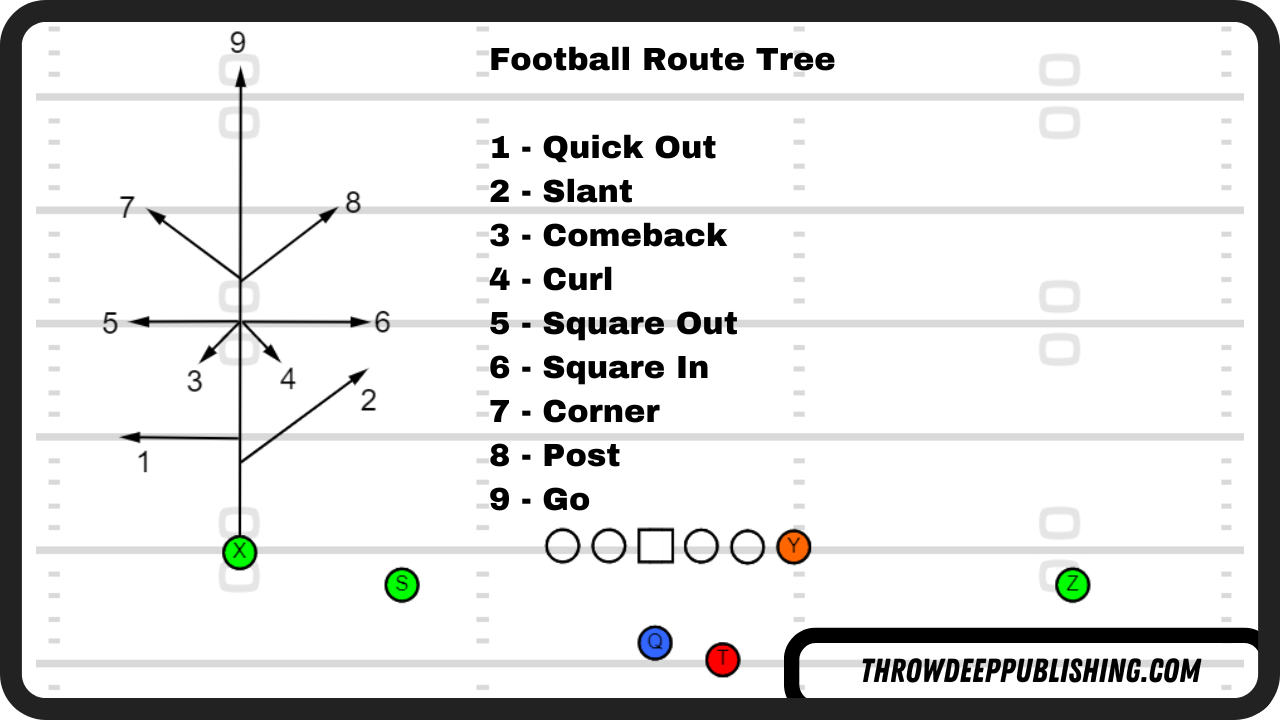
In decades past, it was very common for coaches to use these route trees to actually call the plays. For instance, "999" would tell all receivers to run go routes.
Now days this doesn't happen as much (though some high school teams still use a similar system), but it is still useful as a teaching tool to display the most common routes you want to teach your receivers.
So let's start with the quick routes and keep going from there.
Hitch Route
The hitch route is usually run to about a 5-6 yard depth, at which point the receiver will pivot toward the quarterback and stop, expecting the ball to be thrown to him very quickly.
This is especially effective if the defense is concerned about the threat of the deep ball. If the defense is playing back and giving a big enough "cushion" for the receiver, this should be an easy throw and catch.

One of the simplest routes in the playbook, the hitch route is about getting the ball out of the hands of the quarterback in a hurry, and throwing the ball to your open receiver underneath the coverage.
This route can be run by a receiver lined up outside or in the slot, and can be used in all kinds of different passing plays, like the smash concept .
Slant Route
The slant is a short route that breaks in at roughly a 45 degree angle and is designed give the quarterback a way to get the ball out of his hand. This is one of those football routes that just about every team from high school to the NFL runs in some way.
The slant route gives the receiver the opportunity to beat a defender to the inside and get leverage on him, giving the quarterback a good open throwing window to get him the football.

This route can be added to a run play to create an RPO, and it's also one of the best routes in the playbook for the quarterback to change at the line of scrimmage when he sees the blitz coming before the snap.
There are a couple of ways to run the slant route, depending on where the receiver lines up.
If he's lined up on the outside, usually he will break inside at around 5 yards, or around 3 steps. If he's lined up in the slot, it's a much shorter break, sometimes even just one step before he starts to break inside on the slant angle.
Quick Out Route
The quick out route is a short pass route where the wide receiver will break out toward the sideline at a depth of about five yards and a 90 degree angle. This is used to get the ball out of the quarterback's hands quickly in a rhythm throw.

The route is effective against defenses that are lined up deeper off the receiver. However, the quick out route can be easily defended if the ball is not thrown on time. The quarterback and the receiver must be on the same page, and the ball should be thrown before the receiver breaks toward the sideline.
Stick Route
The stick route is a short route where the receiver will either sit down at about five yards in between zone defenders, or break away from the middle of the field against man coverage.
The stick route designed for a tight end or slot receiver lined up inside the formation, and is used to get the ball to a receiver in the middle of the field. The strengths of the stick route are that it is a short route, so it is easy to complete, and it gives the offense the ability to attack the middle of the field.

The stick route is often confused for a hitch route, since they can look similar, but a receiver running a stick route will typically open up away from the quarterback in most instances.
Most college and professional offenses have the stick as part of their route tree and use it as part of their quick game or RPO passing plays.
You can learn more about the Stick Concept here .
The flat route is a short, horizontal route that is not designed to get any deeper than 2-3 yards past the line of scrimmage .
This route is rarely used on its own, instead being added to other concepts to create vertical or horizontal stretches in the defense, or create rubs against man coverage.

The strengths of the flat route are that it is a quick, easy route to run, and it can be used to create mismatches against slower defenders. The only potential weaknesses of the flat route are that it can be tougher for inexperienced quarterbacks to throw the ball to the receiver in rhythm, which limits his run after catch opportunities, and the route by itself does not go very far down the field.
The whip route is designed to make it look like the receiver running an in-breaking route for a few steps before the receiver turns out toward the sideline underneath.
The whip route is similar to the flat route, since it is rarely designed run on its own, but instead used as a complement to another route in a concept to stretch coverages.

The route is also a favorite for man quarterbacks against man coverage, especially on the goal line, since it can be used to get an athletic receiver open underneath.
Option Route
An option route is a general term for any pass route that gives the receiver multiple paths to choose from based on how the defense reacts. This is sometimes also referred to as a "choice" route for the same reason. There are many different kinds of option routes, but the one in the diagram below is one of the most common, especially at the NFL level.
Option routes are extremely difficult to cover one-on-one, especially when the receiver and quarterback have a lot of experience.

Unfortunately, that is also one of the biggest weaknesses of relying on option routes. The weaknesses are that it is short and takes a lot of time to practice and get right. Since it requires that the quarterback and receiver see exactly the same thing and react the same way.
Coaches like Tiger Ellison and later Mouse Davis used lots of different option routes when developing and running the Run and Shoot Offense for many years, and most NFL offenses use certain kinds of option routes in their playbook.
The go route (sometimes referred to as a fly route) is a deep pass route designed to get the ball to the outside receiver deep down the field.
The route is a low-percentage pass that can create big plays if the quarterback and receiver are on the same page and if the pass is thrown away from the defender covering the receiver.

The best way to run the go route is for the receiver to give himself enough room between his alignment and the sideline, so that the quarterback has a place to put the ball where only the receiver can get to it.
The seam route is a vertical route that runs up the middle of the field and is designed to exploit the space between the linebackers and safeties.
The strengths of the seam route are that it is a difficult route for the linebackers and safeties to cover especially in zone, and it allows the quarterback to throw the ball into tight spaces.

This route works because it attacks the areas between zone defenders, where the defense is less certain about which man is responsible for this area of the field. The receiver can sometimes turn this into a kind of "option route", where he will run straight down the field against one high safety, or "bend" the route to the open space between two safeties.
Corner Route
A corner route is a vertical route, typically run from the slot, where the receiver starts running straight ahead before breaking at an angle of about 45 degrees toward the sideline.
Typically this route breaks out at an angle around a depth of 10 yards, though some offenses allow their receivers to get to 12 yards downfield before making that turn.

The route is effective against both man and zone coverages, and is often run with at least one other route that breaks underneath, to put the defensive backs in maximum conflict, and give the QB lots of room to throw to the open receiver.
The post route is run by sprinting straight down the field, then breaking in at an angle toward the goal posts at around 10-12 yards. The post route is also a good way to get open against two high safety defenses, as it attacks the open space between them in the deep middle of the field.

The post route can be run from the inside or outside receiver position, and is used to either attack the leverage of a specific defender in man coverage, or create a stretch on zone defenses while working with another route to create a conflict in deep zone coverage.
Post Corner Route
The post-corner route is a combination of the post and the corner route, designed to take an advantage of an aggressive defender in pass coverage. The receiver will start off by running what looks like a normal post route, breaking in towards the goal post at 10-12 yards, then breaking back outside on the corner route after 1-3 steps.

The idea is to get the defender in coverage to "bite" on the post route, and then break back outside when the defender's momentum and leverage are already taking him toward where he thought the route was going.
This route is especially useful against man coverage, and in the red zone as well, where a well-thrown post-corner can create all the separation needed for the quarterback to get the ball to a receiver breaking to the outside corner of the end zone.
Square Out Route
The square out route is run vertically down the field to a depth of between 10-12 yards, at which point the receiver will make a hard break toward the sideline. The route, as it is usually drawn up on paper, should show a break to the outside at a hard 90 degree angle.
The route is a good way to attack a defender who is playing too far off the receiver, expecting him to go vertical. It's also a route that relies on a lot of timing between the receiver and the quarterback, so it's not as good of a route if the defensive backs like to press at the line of scrimmage.

This route is usually run by the outside receiver. The route the receiver runs from the slot that resembles a square out is called a "sail" route, and typically the break to the outside is much more rounded and less "sharp" than the square out.
The dig route is any route that starts off vertical and breaks sharply to the middle of the field at a depth of anywhere from 10-15 yards . This route can be run from either the inside or the outside, though the route will usually look different depending on which position the receiver runs the route from.
The dig route is often used to get the ball to a receiver in the middle of the field, between the hashes, and is also valuable in different pass concepts that stretch the defense in the middle, like the Yankee Concept .

When running the dig route from the outside, the break to the middle is a 2-part process, where the receiver will first break in at an angle, and then a couple of yards later he'll cut flat across the middle, like the picture below.
On the other hand, when the receiver runs the route from the slot, it's a much quicker and harder cut, a pivot at a 90 degree angle, and breaking flat across the middle like the picture below.

The curl route is an intermediate route where the receiver will run vertically to around a 10-12 yard depth, then break back toward the quarterback and "sit" in the first available open space in the defense. The route is named because of the way the receiver's path resembles a "curl" when drawn up on paper.

This is usually run by the outside receiver position in combination with some sort of underneath route to the same side to stretch a zone defense and create an opening for the QB to throw the ball.
Comeback Route
The comeback route starts with a vertical release attacking downfield, and then the receiver breaks back at an angle toward the sideline. The ball should be thrown on time from the quarterback so that the receiver has a chance to catch the ball as soon as he comes out of his break. This is called a comeback route because the receiver literally comes back to the ball out of his break, and the quarterback throws it behind him.

Completing this pass takes an incredible amount of timing and discipline from both the quarterback and the receiver, since the ball must be thrown on time, and also to the right spot (away from the defender).
This is one of the toughest routes to throw consistently well, but when the offense is on the same page, it's also one of the toughest to defend.
The drag route is a horizontal route that starts off very short and sees the receiver drifting deeper as he crosses the field, usually no deeper than 6-8 yards. The route is used on a lot of plays that move the quarterback, like bootlegs and sprint out passes, since it allows the receiver to stay "even" with the quarterback and catch the ball on the run.

The route is designed to get the ball to the receiver as he's moving from one side to the other, and create opportunities for yards after the catch.
Shallow Cross Route
The shallow cross route is a short route where the receiver stays no deeper than 2-3 yards past the line of scrimmage while running from on side of the field to the other.
The idea behind the route is so that the quarterback can get the ball to the receiver on the run, and it gives faster receivers the ability to run away and create space between them and defenders trailing in man coverage.

The route can also be paired with other deeper routes to stretch the middle of the defense and create space against zone. This is exactly where the Shallow Cross Concept gets its name.
Check our collection of books of football plays .
- Choosing a selection results in a full page refresh.
- Press the space key then arrow keys to make a selection.
Fundamental Pass Concepts
Two-man pass concepts.
These are some of the most common two man and three man pass concepts. This is not a definitive list, but a list of most common passing concepts that I've seen or ran at some point. These concepts are so common because they work. I've left out some of the Air Raid concepts because I have a separate breakdown here . Some of the specific terminology is omitted because there are multiple names for the concept across different coaches and systems. I also think that coaches get hung up on terminology too often. Call it something you and your kids will remember. This will be updated as time goes on.
🚨WORK IN PROGRESS🚨
Slant Flat "Dragon"
Double Slant
Curl Flat "Hank"
Deep Out "Hawk"
Seam Curl "Hoss"
Slot Fade "66"
"Mills"
Three-Man Pass concepts
Flood 2x2 "Sail"
Flood 3x1 "Sail"
Full Field Concepts
Full field Concepts, such as Mesh, Y-Cross and Shallow can be found in the AIR RAID breakdown.
Hoss Y Juke
Hoss Y-Juke is a great play out of empty to take advantage of split field coverage's. One of the weaknesses in a split field coverage vs. empty is that the Mike linebacker will usually matched up on the #3 receiver to the strong side. This concept relies on the quickness of the #3 receiver to win that match up every time.
X: Hitch vs. soft coverage. Fade vs Press.
F: Seam route, look for grass.
Y: Juke route. Sit if LB moves or doesn't match up with you. Whip if LB is in man or wall off inside. Run if LB plays head up or open grass in the middle of the field.
H: Seam route, look for grass.
Z: Hitch vs. soft coverage. Fade vs Press.
QB: Against 2 high safeties read the Juke. Against 1 high read hitch to seam on the side with the best leverage. Look for pressed corners and grass.
Bill O'Brien Hoss Y- Juke Patriots
Noah Riley Hoss Y-Juke Cutups
Yankee is a deep cross concept that is a great way to attack single high safeties. This concept is usually run out of heavy formations so the defense has to commit multiple defenders to the run. Most teams will run this a s a play-action concept with a 7+ man protection. This play is great if you have fast receivers on your team to get to the deep throw quicker. There are multiple variation of the Yankee concept, but the hallmarks of the play remain the same. A deep cross with a post.
X: Inside release. Break at 15 yards. Look for grass.
F: Check release.
Y: 5-6 yard drag.
H: Pass protect.
Z: Inside release. Break to post at 15 yards. Look for grass.
Saints "Yankee" Vs. Tampa Bay
Arizona "Yankee" Vs. Wash.
Dagger is a concept that is commonly used in high school, college and the NFL. It involves a vertical route by the slot receiver a deep dig from the outside receiver and a drag from a backside receiver. This stretches the defense vertically and horizontally and put pressure on a deep safety to make a play.
X: Inside release. Deep Dig. Break at 15 yards and look for grass.
H: Seam. Must get vertical to occupy as many deep defenders as possible.
F: Check release backside.
Z: 12-15 yard deep comeback. Can continue route vertical against man coverage.
QB: Read Dig - Shallow but peek at the Seam. Dig is the most likely to be open but peek at the seam to get a cheap quick shot down the field.
This play can be run a variety of ways and out of multiple formations. Tweak this to your personnel and game plan.

Bills "Dagger" Vs. Saints
Eagles 3x1 "Dagger"
This concept is a variation of shallow that is quick and easy to install in any offense. It can be run out of multiple formations and can be tweaked to fit personnel easily. The hallmarks of the Drive concept is a same side shallow and dig combination. This is usually paired with a post or seam route over the top of the play.
X: Outside release, get vertical.
H: Post route. Break at 10-12 yards. Can adjust to a skinny post or seam against one high defenses.
Y: 10-12 yard Dig. Outside release on the snap.
Z: Tight split to the Y. Run the shallow route at the heels of the DL. Must scream to the sideline and not stop their route.
QB: Read the Mike. If he comes up on the shallow throw the dig and if he drops throw the shallow. Peek at the post. F is checkdown.
There are multiple ways to run this play, too many to count. This is an effective way to attack the middle of the field, and its usually a pretty easy throw for the QB.
Arkansas 2010 "Drive"
"Drive" w/ "Mills" from 3x1
Search This Blog
Breakdown sports.
An in-depth look at football with discussion on strategy, plays, ideas, concepts, and techniques, with a particular focus on the Big Ten.
Football Fundamentals: Twins Passing Concepts

- Levels – Any Route Combination between the numbers that has one underneath and one over top route
- Hi-Lo – Any Route Combination outside the numbers that has one underneath and one over top route
- In-Out – Any Route Combination that attacks adjacent zones at the same level
- One-on-One – Route combination designed to isolate coverage on a receiver. Often option routes
- Vertical – Route combinations designed to attack deep areas of the field
- Delta – Three person concept that attacks Hi-Lo and In-Out

Post a Comment
Popular posts from this blog, football fundamentals: 2x2 and mirrored passing concepts.

Football Fundamentals: The Tite Front Defense


- All 9 Football Routes Explained with Images (The Route Tree)
By Coach Martin | Football Basics
- You are here:
- Football Basics
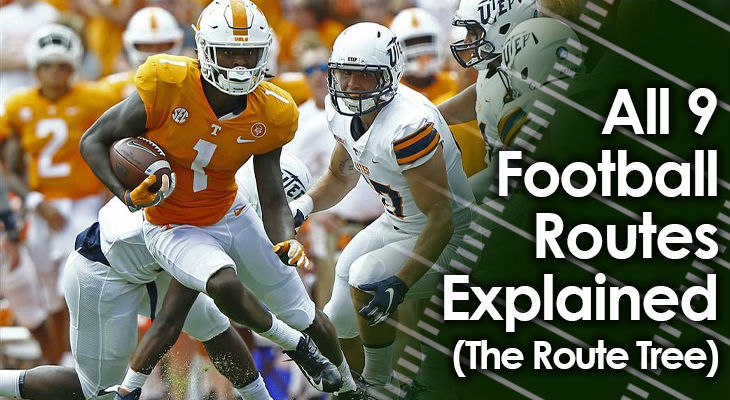
Understanding the many different football routes is important for every player and coach.
On any given play, each receiver on the field will be asked to run a specific route to attack the different levels of the defense, and to keep the defenders off balance.
But let’s first start with the basics…
Free Download:
"The Ultimate Guide to Football Defense" Booklet (254 pages)
What is the “Route Tree”?
Every pass catcher (no matter what position he plays or where he lines up on the field) will be asked to run a variation of one of nine basic football routes.
These 9 routes make up the “Route Tree”.
And the reason why it’s called a route tree (as you’ll see in the images below) is that when they’re all drawn together on a play sheet, the routes form what looks like a tree.
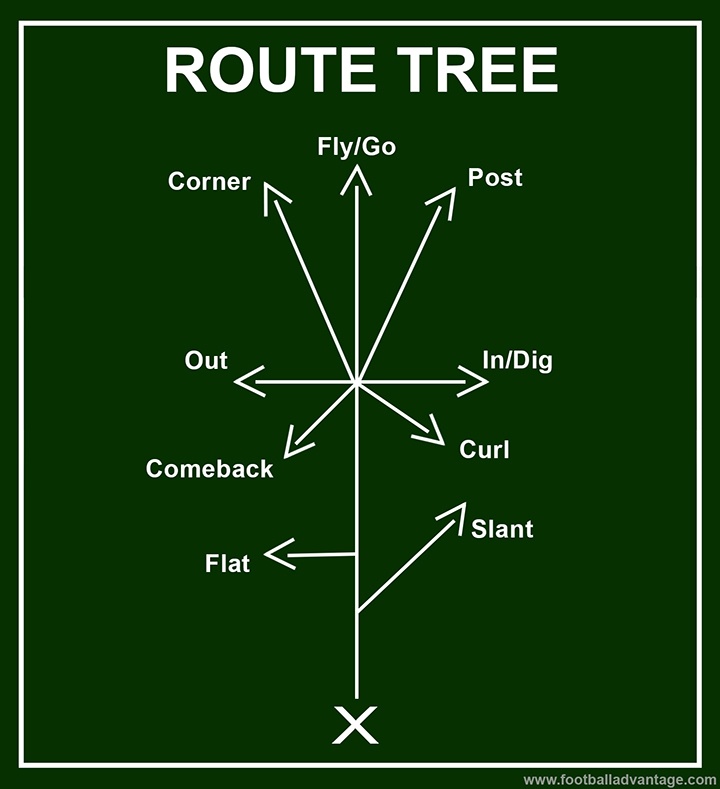
Having a good understanding of each of the nine football routes, how they’re run, and the situations in which they’re most often used is very important.
Below, I’ve listed each of them in order of shortest to longest depth from the line of scrimmage.
Let’s get started...
#1 – The Flat Route

The flat route is a basic route that quickly breaks to the outside of the field, toward the sideline.
The receiver will take a few steps forward, then immediately cut to his left or right towards the closest sideline.
The flat route is usually run by either wide receivers lined up in the slot, tight ends, or running backs.
They aren’t typically run by outside wide receivers simply because of the limited amount of space between the sideline and where they line up on the field.
#2 – The Slant Route
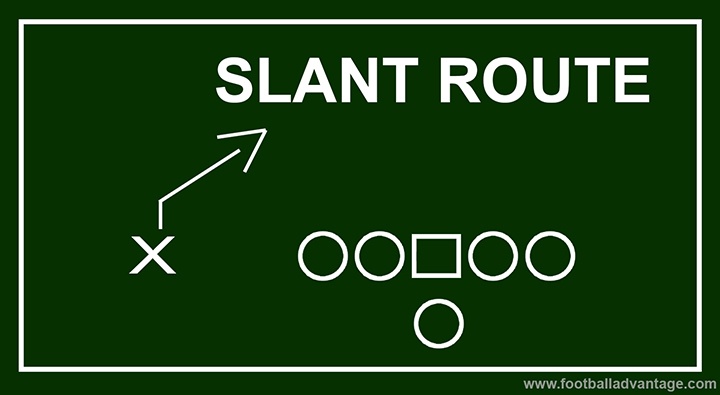
A slant is similar to a flat route in that it’s a quick-hitting football route.
The receiver will take a few steps forward, then use an inside break to slant diagonally across the field.
The idea is to get separation between the receiver and the defender, and to put the receiver’s body between the defender and the quarterback.
Slant routes can be run by any position, from any alignment, and at any depth.
Slants can be run on short, medium or deep depths on the field.
They are quick-hitting routes, though, so the quarterback will usually get the ball out of his hand quickly if he throws to someone running a slant.
#3 – The Comeback Route
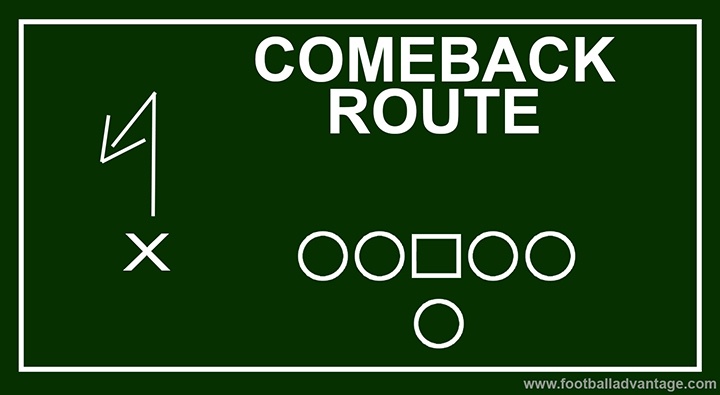
The comeback route is designed to run just like its name describes.
The receiver will sprint straight downfield, then quickly stop in his tracks and slant back toward the line of scrimmage and the sideline.
This football route is typically only run by an outside wide receiver, because it utilizes the sideline and the receiver’s ability to shield the defender from the ball by using both his body and the sideline.
It’s most often used in combination with a quarterback’s back-shoulder throw that is so popular in today’s game of professional football, with quarterbacks throwing to a part of the receiver’s body that only the receiver can get to.
#4 – The Curl Route
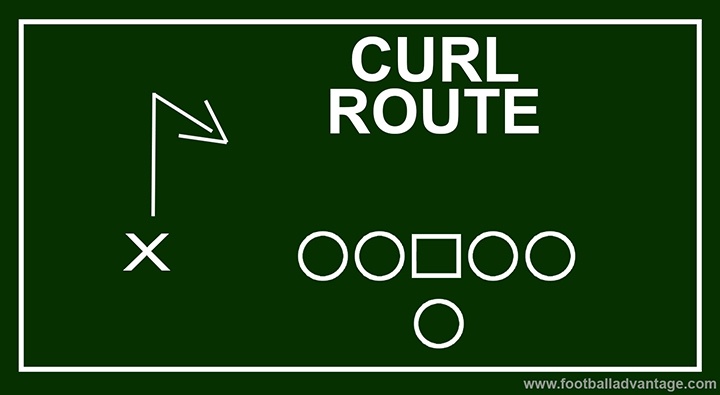
The curl can also be called the stop route.
It’s the exact opposite of the comeback in that the movement back toward the line of scrimmage after the stop is toward the middle of the field instead of toward the sideline.
Because of this, it’s a route that is most often run from players lined up toward the inside of the field. In fact, the curl route is often used inside in combination with the comeback route being run outside.
In this football route, the receiver will sprint directly downfield, then stop and curl back to the inside of the field, away from the closest sideline.
#5 – The Out Route
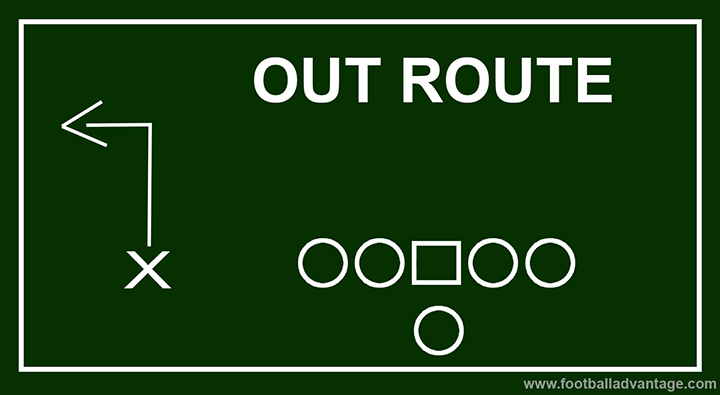
The out route is similar in look to the flat route, but it is done at a much deeper depth.
Completing this route successfully will require not only good execution from the receiver, but a strong arm from the quarterback, as the ball will be in the air for quite some time before it reaches the receiver.
For all intents and purposes, an out route is a flat that is run at a depth of about 10 to 15 yards downfield instead of only few yards off the line of scrimmage.
Again, this football route is often run by receivers who aren’t lined up on the far outside of the field, because it requires taking advantage of the sideline.
Oftentimes, receivers who run this route will catch the ball very close to the sideline after running 10 to 15 yards vertically, then another five to 10 yards horizontally.
#6 – The In or Dig Route

This route goes by two names, either the “In” or the “Dig”.
In effect, it’s the exact opposite of the Out route.
The receiver will sprint 10 to 15 yards straight downfield, then stop and cut directly across the field in a straight horizontal direction toward the inside of the field.
The In or Dig requires a receiver who is very precise in route running.
That’s because he must decoy the defender into thinking he’s running a straight deep route and then quickly and precisely cut across the middle, creating separation from the defender without the benefit of the sideline’s help.
In fact, the In or Dig route will put the receiver in harm’s way of extra defenders as he runs across the middle of the field.
#7 – The Corner Route
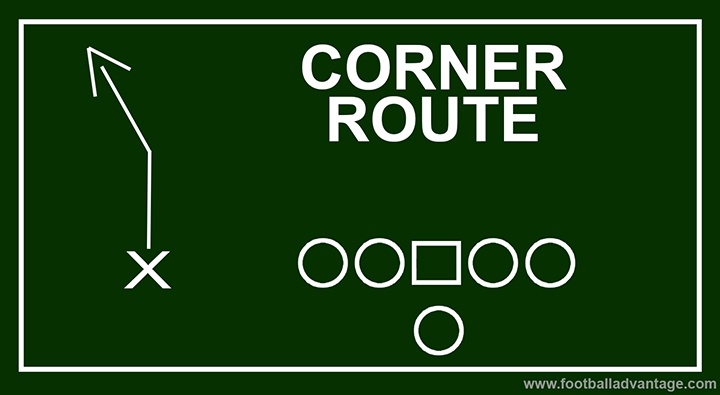
The last three routes on the Route Tree are the deeper-depth routes.
Like its name suggests, the corner route attacks the deep outside corner of the field.
The receiver will run at a depth of 10 to 15 yards straight ahead, then run in a diagonal direction toward the deep outside part of the field.
This corner route is similar to the slant route in that it finishes with in a diagonal direction.
However, the idea isn’t to make a sharp cut that limits the depth of the route, but rather to slant to the outside at an angle that also allows the receiver to get some depth.
This football route is created to attack the safeties, especially in a zone defense where the safeties provide extra protection over the top.
The route will not only be a potential for big pass completion to the receiver who runs it, but will also clear out the middle of the field for other receivers who might be running routes over the middle of the field at shorter depths.
#8 – The Post Route
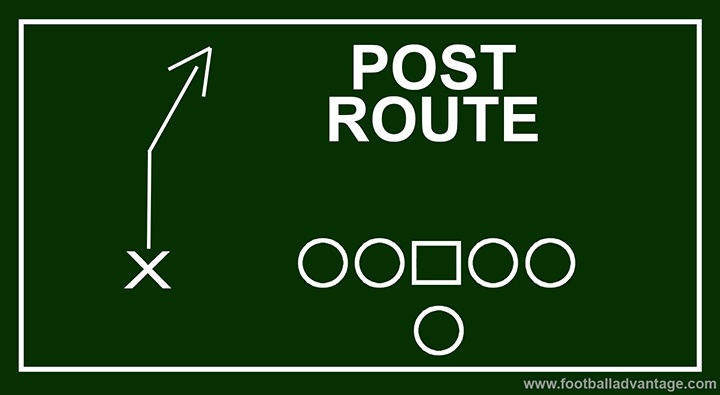
As you might have predicted, the post route is the sister to the corner route.
It’s run in the exact same fashion, except that the diagonal direction is toward the inside of the field instead of the outside.
This is a route that will attack the safeties again in the same fashion that the corner route does.
In this football route, though, the quarterback will often throw a deep ball to an open area of the field and allow the receiver to use his speed and separation to go run under it.
The idea here is to not only create space between the receiver and defender, and not only to open up space over the middle of the field, but to also attack a separate open space deep down the middle.
#9 – The Fly Route
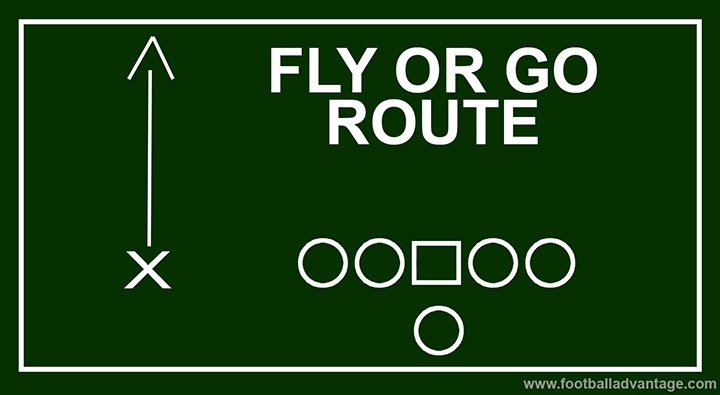
The last football route on the tree is the simplest.
Quite simply, the fly route asks the receiver to go deep.
That’s why it is often referred to as the “Go” route.
The receiver is asked to run as fast as he can as deep as he can straight down the field from where he lined up.
The idea is to get separation from the defender who might be anticipating that the receiver will break off the vertical direction of the route and end up running any of the other routes on the Route Tree.
The speed of the receiver should force the defender to break out of his backpedal motion and turn his back to the line of scrimmage to run with the receiver.
This should allow the receiver to have the advantage of knowing when the ball is thrown and where it is traveling, while the defender won’t have that same information.
The quarterback will need to have a strong arm to complete a pass to a receiver running a fly route, as the ball will often travel at least 30 yards in the air before it reaches the receiver’s hands.
Combination Routes
While there are only nine true routes on the Route Tree, there are three more that are run quite often that are designed to be combinations of nine basic routes.
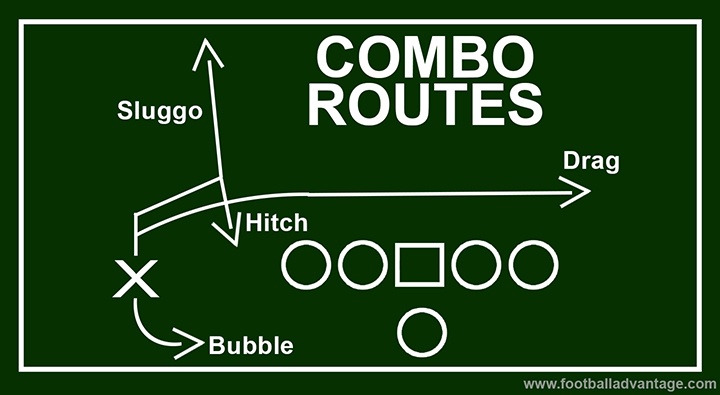
a. The “Sluggo” Route
The sluggo is a combination of the slant and go routes, which is how it gets its name.
The route will start as a slant route, with the receiver taking a few steps forward and then slanting toward the middle of the field…
But then end as a go route, with the receiver halting the slant route and turning it into a go route to the deep portion of the field.
b. The “Bubble” Route
This is a screen route that can be run by any player lined up as a wide receiver.
Instead of moving forward at the snap of the ball, the receiver will take a step back and move slightly toward the quarterback as the ball is thrown to him on a screen play.
The idea is to get the receiver the ball quickly and let him use his speed and skill to break tackles and gain yardage.
c. The “Drag” Route
This is similar to a slant route, but instead of the receiver making a sharp cut to the middle, he rounds out the cut and “drags” the route further across the field toward the opposite sideline.
This is a longer-developing route than the slant route is, and the receiver will typically run almost the width of the field from start to finish.
Double Moves
The Sluggo route is the most common type of double moves that receivers use to try to confuse the defender.
Others are the hitch route, where the defender might start by running a slant, but then stop in his tracks and occupy a certain spot on the field.
Conclusion:
The idea behind the Route Tree is not just to create a pretty picture with all the different types of football routes that receivers can run...
Instead, it hammers home the concept that route running, much like a tree, is most successful when it has all the parts – a trunk and branches and different heights or depths.
The best offensive passing plays are those that use multiple football routes in the tree in the same play to cause confusion among defensive players.
And also open as much space as possible for receivers to roam.
Related Posts:
What is a Offensive Tackle in Football? (OT Position Guide)
What is a Defensive Tackle in Football? (DT Position Guide)
What is a Center in Football? (Full Position Guide)
What is a Long Snapper in Football? (LS Position Guide)
Leave a Comment:
Save my name, email, and website in this browser for the next time I comment.
(4) comments
You gave a good explanation of the routes,combined routes,and double moves.
[…] All wide receivers must learn the nine basic routes in what's known as the Route Tree. […]
[…] idea here is that by running routes at all different levels of the defense, safeties won’t be able to help out in shorter passing […]
The Ultimate Guide to Football Defense
15 fantastic defensive strategies (250 pages).
Enter your email below to get access for free:
100% Privacy Guarantee. Your email address is safe with me
Watch CBS News
Solar eclipse maps show 2024 totality path, peak times and how much of the eclipse people could see across the U.S.
By Aliza Chasan
Updated on: April 9, 2024 / 5:00 AM EDT / CBS News
A total solar eclipse crossed North America Monday with parts of 15 U.S. states within the path of totality. Maps show where and when astronomy fans could see the big event as skies darkened in the middle of the day Monday, April 8.
The total eclipse first appeared along Mexico's Pacific Coast at around 11:07 a.m. PDT, then traveled across a swath of the U.S., from Texas to Maine, and into Canada.
About 31.6 million people live in the path of totality , the area where the moon fully blocked out the sun , according to NASA. The path ranged between 108 and 122 miles wide. An additional 150 million people live within 200 miles of the path of totality.
Solar eclipse path of totality map for 2024

The total solar eclipse started over the Pacific Ocean, and the first location in continental North America that experienced totality was Mexico's Pacific Coast, around 11:07 a.m. PDT, according to NASA. From there, the path continued into Texas, crossing more than a dozen states before the eclipse enters Canada in southern Ontario. The eclipse exited continental North America at around 5:16 p.m. NDT from Newfoundland, Canada.
The path of totality included portions of the following states:
- Pennsylvania
- New Hampshire
Small parts of Tennessee and Michigan also experienced the total solar eclipse.
Several major cities across the U.S. were included in the eclipse's path of totality, while many others saw a partial eclipse. These were some of the best major cities for eclipse viewing — though the weather was a factor :
- San Antonio, Texas (partially under the path)
- Austin, Texas
- Waco, Texas
- Dallas, Texas
- Little Rock, Arkansas
- Indianapolis, Indiana
- Dayton, Ohio
- Cleveland, Ohio
- Buffalo, New York
- Rochester, New York
- Syracuse, New York
- Burlington, Vermont
Map of when the solar eclipse reached totality across its path
The eclipse began in the U.S. as a partial eclipse beginning at 12:06 p.m. CDT near Eagle Pass, Texas, before progressing to totality by about 1:27 p.m. CDT and then moving along its path to the northeast over the following few hours.
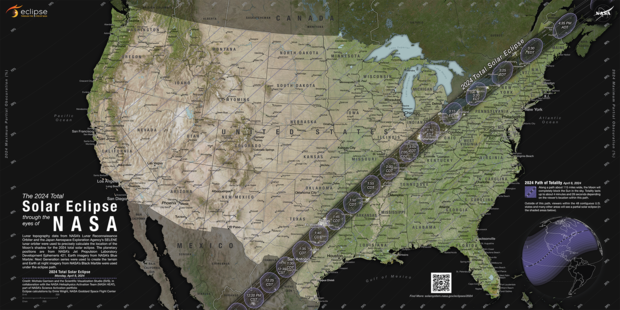
NASA shared times for several cities in the path of totality across the U.S. People could have also checked their ZIP code on NASA's map to see when the eclipse was to reach them if they were on, or near, the path of totality — or if they saw a partial eclipse instead.
How much of the eclipse did people see if they live outside the totality path?
While the April 8 eclipse covered a wide swath of the U.S., outside the path of totality observers may have spotted a partial eclipse, where the moon covers some, but not all, of the sun, according to NASA. The closer they were to the path of totality, the larger the portion of the sun that was hidden.
NASA allowed viewers to input a ZIP code and see how much of the sun was to be covered in their locations.
Could there be cloud cover be during the solar eclipse?
Some areas along the path of totality had a higher likelihood of cloud cover that could interfere with viewing the eclipse. Here is a map showing the historical trends in cloud cover this time of year.
You could have checked the latest forecast for your location with our partners at The Weather Channel .

Where did the solar eclipse reach totality for the longest?
Eclipse viewers near Torreón, Mexico, got to experience totality for the longest. Totality there lasted 4 minutes, 28 seconds, according to NASA.
Most places along the centerline of the path of totality saw a totality duration of between 3.5 and 4 minutes, according to NASA. Some places in the U.S. came close to the maximum; Kerrville, Texas, had a totality duration of 4 minutes, 24 seconds.
What is the path of totality for the 2044 solar eclipse?
The next total solar eclipse that will be visible from the contiguous U.S. will be on Aug. 23, 2044.
Astronomy fans in the U.S. will have far fewer opportunities to see the 2044 eclipse they had on April 8. NASA has not yet made maps available for the 2044 eclipse but, according to The Planetary Society , the path of totality will only touch three states.
The 2024 eclipse will start in Greenland, pass over Canada and end as the sun sets in Montana, North Dakota and South Dakota, according to the Planetary Society.

Aliza Chasan is a digital producer at 60 Minutes and CBSNews.com. She has previously written for outlets including PIX11 News, The New York Daily News, Inside Edition and DNAinfo. Aliza covers trending news, often focusing on crime and politics.
More from CBS News

Transcript: Ret. Gen. Frank McKenzie on "Face the Nation," April 14, 2024

Here's how to get a tax extension from the IRS in 2024

Truck plows into Texas DPS office in "intentional" act, killing 1, officials say
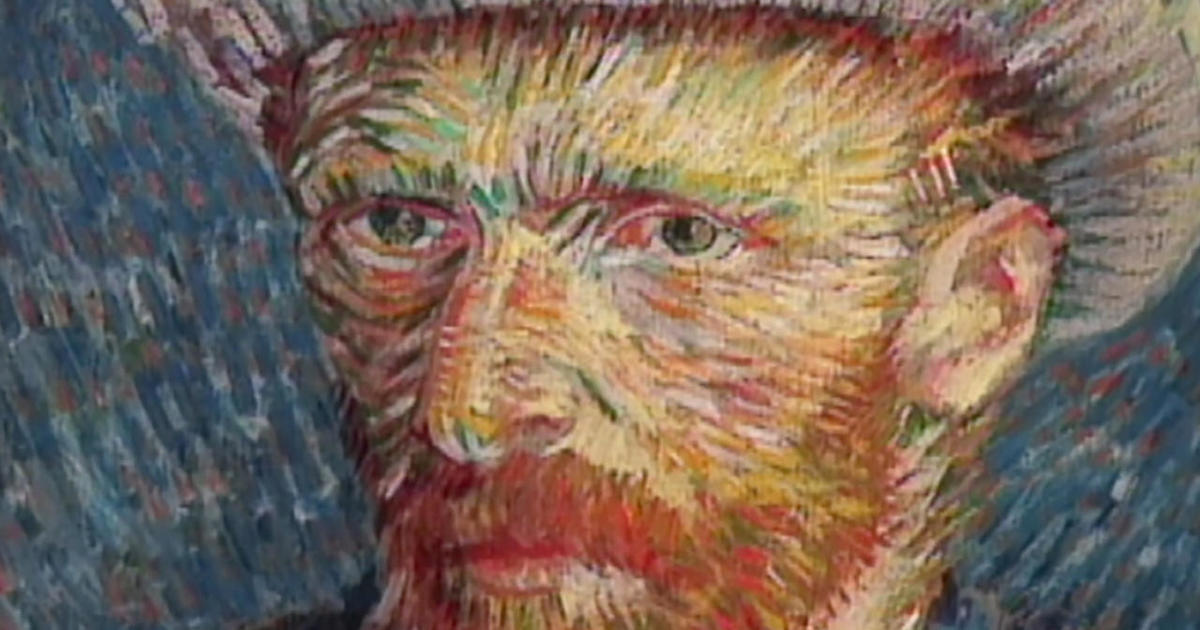
"Sunday Morning" archives: Impressionism at 150
- Solar Eclipse 2024
See the 2024 Solar Eclipse’s Path of Totality
A total solar eclipse is expected to pass through the United States on April 8, 2024, giving stargazers across the country the opportunity to view the celestial phenomenon in which the sun is completely covered by the moon.
The eclipse will enter the U.S. in Texas and exit in Maine. It is the last time a total solar eclipse will be visible in the contiguous United States until 2044.
Here's what to know about the path of the eclipse and where you can see it.
Read More : How Animals and Nature React to an Eclipse
Where can you see the total solar eclipse?
The eclipse will cross through North America, passing over parts of Mexico, the United States, and Canada.
The eclipse will enter the United States in Texas, and travel through Oklahoma, Arkansas, Missouri, Illinois, Kentucky, Indiana, Ohio, Pennsylvania, New York, Vermont, New Hampshire, and Maine. Small parts of Tennessee and Michigan will also experience the total solar eclipse.
Much of the eclipse's visibility depends on the weather. A cloudy day could prevent visitors from seeing the spectacle altogether.
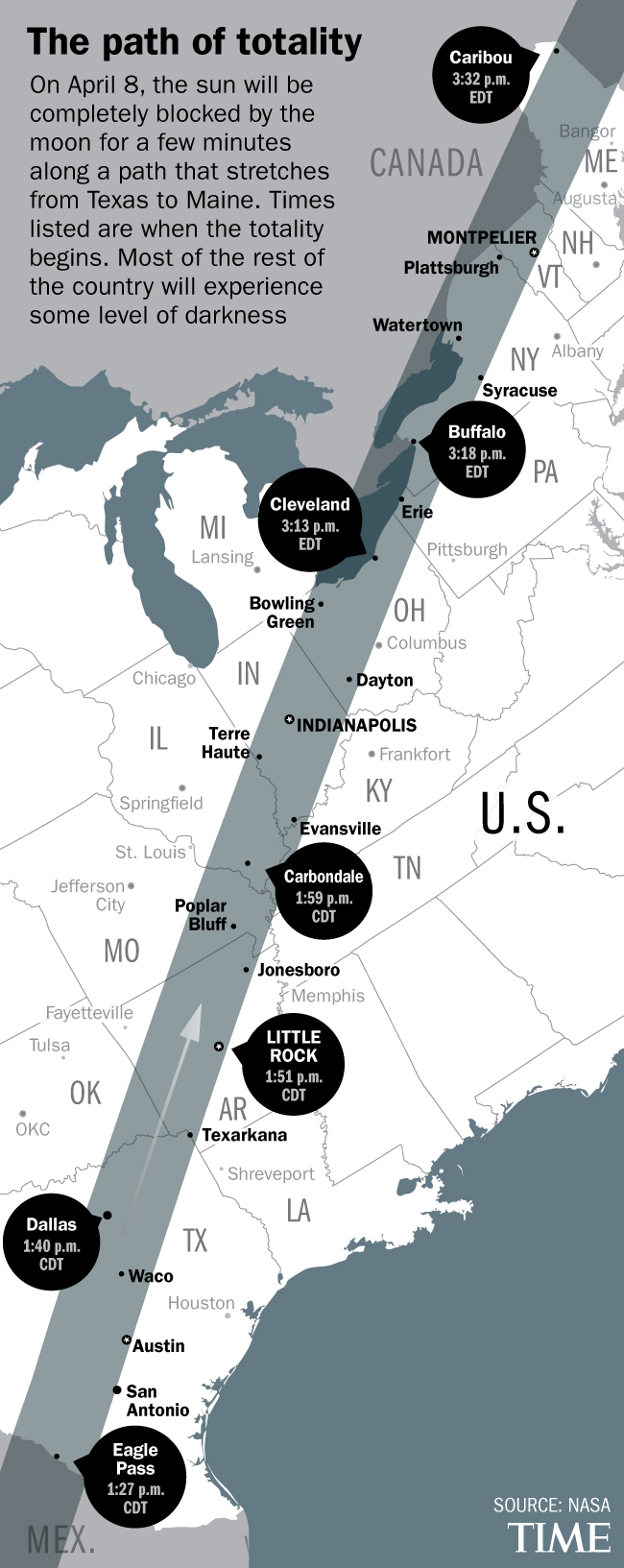
When does the solar eclipse start and end?
The solar eclipse will begin in Mexico’s Pacific coast at around 11:07 a.m. PDT. It will exit continental North America on the Atlantic coast of Newfoundland, Canada, at 5:16 p.m. NDT.
The longest duration of totality—which is when the moon completely covers the sun — will be 4 minutes, 28 seconds, near Torreón, Mexico. Most places along the path of totality will see a totality duration between 3.5 and 4 minutes.
Read More : The Eclipse Could Bring $1.5 Billion Into States on the Path of Totality
Where’s the best place to see the total solar eclipse?
The best place to witness the event is along the path of totality. Thirteen states will be along the path of totality, and many towns across the country are preparing for the deluge of visitors— planning eclipse watch parties and events in the days leading up to totality.
In Rochester, NY, the Rochester Museum and Science Center is hosting a multi-day festival that includes a range of events and activities. Russellville, Arkansas will host an event with activities including live music, science presentations, tethered hot-air balloon rides, and telescope viewings.
More Must-Reads From TIME
- Exclusive: Google Workers Revolt Over $1.2 Billion Contract With Israel
- Jane Fonda Champions Climate Action for Every Generation
- Stop Looking for Your Forever Home
- The Sympathizer Counters 50 Years of Hollywood Vietnam War Narratives
- The Bliss of Seeing the Eclipse From Cleveland
- Hormonal Birth Control Doesn’t Deserve Its Bad Reputation
- The Best TV Shows to Watch on Peacock
- Want Weekly Recs on What to Watch, Read, and More? Sign Up for Worth Your Time
Write to Simmone Shah at [email protected]
When will solar eclipse reach your town? These maps show path's timing, how long it lasts.
Hundreds of cities in 13 u.s. states fall directly on the april 8 eclipse's path of totality as the moon blocks the sun's disc and ushers in darkness. these interactive maps offer a closer look..

Come Monday, millions of Americans from Texas to Maine will stop what they're doing to step outside and spend a few minutes gazing skyward .
Few celestial events have the power to capture our collective attention the way this upcoming total solar eclipse has managed to do. And for those making time to witness it, two questions are bound to be on their mind : Will totality reach my area and if so, how long will the resulting darkness last?
Most people across the country are bound to experience the eclipse in some form, but only 13 states fall directly on the path of totality, where the moon will appear large enough to shield all but the sun's outermost layer, the corona.
As you make your eclipse-viewing plans, these interactive maps should help you chart the time and duration for when totality will occur in cities along the path.
Solar eclipse experiment: Here's why NASA is launching 3 sounding rockets into space during the total solar eclipse
Total solar eclipse path of totality map
The 115-mile-wide path of totality will pass from southwest to northeast over portions of Mexico the United States and Canada.
Mexico's Pacific coast will be the first location in continental North America to experience totality, which will occur at about 11:07 a.m. PDT, according to NASA .
As the moon's shadow travels northeast, totality in the U.S. will begin at 1:27 p.m. CDT in Eagle Pass, Texas. From there, the path will cut diagonally across the country before ending around 3:35 p.m. EDT in Lee, Maine.
Remember: If you plan to witness the eclipse, proper eyewear is a must until the eclipse reaches totality, then it can be viewed with the naked eye.
Here's a map of some of the larger cities in each of the 13 states on the path to show how the duration of totality will vary:
Cities, states on the path of totality
All told, nearly 500 cities in 13 U.S. states are located on the eclipse's path of totality. Here are some of the major cities in each of the 13 states:
- Dallas and San Antonio, Texas
- Idabel, Oklahoma
- Poplar Bluff, Missouri
- Little Rock, Arkansas
- Paducah, Kentucky
- Indianapolis and Evansville, Indiana
- Carbondale, Illinois
- Cleveland and Toledo, Ohio
- Buffalo, Rochester and Syracuse, New York
- Burlington, Vermont
- Lancaster, New Hampshire
- Caribou, Maine
- Erie, Pennsylvania
This interactive map provides a closer look at cities along the path, when totality will arrive there and how long totality will last:
Eclipse watch parties, festivals
Such a rare event is sure to attract skygazing tourists unlucky enough to live outside the path of totality. Fortunately, many cities that will experience the total eclipse are planning plenty of festivities for tourists and locals alike.
This map , courtesy of Kristian Campana at festivalguidesandreviews.com , includes locations of watch parties, music festivals and more all tied to the eclipse's arrival:
Trains Moscow to Elektrostal: Times, Prices and Tickets
- Train Times
- Seasonality
- Accommodations
Moscow to Elektrostal by train
The journey from Moscow to Elektrostal by train is 32.44 mi and takes 2 hr 7 min. There are 71 connections per day, with the first departure at 12:15 AM and the last at 11:46 PM. It is possible to travel from Moscow to Elektrostal by train for as little as or as much as . The best price for this journey is .
Get from Moscow to Elektrostal with Virail
Virail's search tool will provide you with the options you need when you want to go from Moscow to Elektrostal. All you need to do is enter the dates of your planned journey, and let us take care of everything else. Our engine does the hard work, searching through thousands of routes offered by our trusted travel partners to show you options for traveling by train, bus, plane, or carpool. You can filter the results to suit your needs. There are a number of filtering options, including price, one-way or round trip, departure or arrival time, duration of journey, or number of connections. Soon you'll find the best choice for your journey. When you're ready, Virail will transfer you to the provider's website to complete the booking. No matter where you're going, get there with Virail.
How can I find the cheapest train tickets to get from Moscow to Elektrostal?
Prices will vary when you travel from Moscow to Elektrostal. On average, though, you'll pay about for a train ticket. You can find train tickets for prices as low as , but it may require some flexibility with your travel plans. If you're looking for a low price, you may need to prepare to spend more time in transit. You can also often find cheaper train tickets at particular times of day, or on certain days of the week. Of course, ticket prices often change during the year, too; expect to pay more in peak season. For the lowest prices, it's usually best to make your reservation in advance. Be careful, though, as many providers do not offer refunds or exchanges on their cheapest train tickets. Unfortunately, no price was found for your trip from Moscow to Elektrostal. Selecting a new departure or arrival city, without dramatically changing your itinerary could help you find price results. Prices will vary when you travel from Moscow to Elektrostal. On average, though, you'll pay about for a train ticket. If you're looking for a low price, you may need to prepare to spend more time in transit. You can also often find cheaper train tickets at particular times of day, or on certain days of the week. Of course, ticket prices often change during the year, too; expect to pay more in peak season. For the lowest prices, it's usually best to make your reservation in advance. Be careful, though, as many providers do not offer refunds or exchanges on their cheapest train tickets.
How long does it take to get from Moscow to Elektrostal by train?
The journey between Moscow and Elektrostal by train is approximately 32.44 mi. It will take you more or less 2 hr 7 min to complete this journey. This average figure does not take into account any delays that might arise on your route in exceptional circumstances. If you are planning to make a connection or operating on a tight schedule, give yourself plenty of time. The distance between Moscow and Elektrostal is around 32.44 mi. Depending on the exact route and provider you travel with, your journey time can vary. On average, this journey will take approximately 2 hr 7 min. However, the fastest routes between Moscow and Elektrostal take 1 hr 3 min. If a fast journey is a priority for you when traveling, look out for express services that may get you there faster. Some flexibility may be necessary when booking. Often, these services only leave at particular times of day - or even on certain days of the week. You may also find a faster journey by taking an indirect route and connecting in another station along the way.
How many journeys from Moscow to Elektrostal are there every day?
On average, there are 71 daily departures from Moscow to Elektrostal. However, there may be more or less on different days. Providers' timetables can change on certain days of the week or public holidays, and many also vary at particular times of year. Some providers change their schedules during the summer season, for example. At very busy times, there may be up to departures each day. The providers that travel along this route include , and each operates according to their own specific schedules. As a traveler, you may prefer a direct journey, or you may not mind making changes and connections. If you have heavy suitcases, a direct journey could be best; otherwise, you might be able to save money and enjoy more flexibility by making a change along the way. Every day, there are an average of 18 departures from Moscow which travel directly to Elektrostal. There are 53 journeys with one change or more. Unfortunately, no connection was found for your trip from Moscow to Elektrostal. Selecting a new departure or arrival city, without dramatically changing your itinerary could help you find connections.
Book in advance and save
If you're looking for the best deal for your trip from Moscow to Elektrostal, booking train tickets in advance is a great way to save money, but keep in mind that advance tickets are usually not available until 3 months before your travel date.
Stay flexible with your travel time and explore off-peak journeys
Planning your trips around off-peak travel times not only means that you'll be able to avoid the crowds, but can also end up saving you money. Being flexible with your schedule and considering alternative routes or times will significantly impact the amount of money you spend on getting from Moscow to Elektrostal.
Always check special offers
Checking on the latest deals can help save a lot of money, making it worth taking the time to browse and compare prices. So make sure you get the best deal on your ticket and take advantage of special fares for children, youth and seniors as well as discounts for groups.
Unlock the potential of slower trains or connecting trains
If you're planning a trip with some flexible time, why not opt for the scenic route? Taking slower trains or connecting trains that make more stops may save you money on your ticket – definitely worth considering if it fits in your schedule.
Best time to book cheap train tickets from Moscow to Elektrostal
The cheapest Moscow - Elektrostal train tickets can be found for as low as $35.01 if you’re lucky, or $54.00 on average. The most expensive ticket can cost as much as $77.49.
Find the best day to travel to Elektrostal by train
When travelling to Elektrostal by train, if you want to avoid crowds you can check how frequently our customers are travelling in the next 30-days using the graph below. On average, the peak hours to travel are between 6:30am and 9am in the morning, or between 4pm and 7pm in the evening. Please keep this in mind when travelling to your point of departure as you may need some extra time to arrive, particularly in big cities!
Moscow to Elektrostal CO2 Emissions by Train

Anything we can improve?
Frequently Asked Questions
Go local from moscow, trending routes, weekend getaways from moscow, international routes from moscow and nearby areas, other destinations from moscow, other popular routes.
Your last-minute guide to Monday's total solar eclipse

A total solar eclipse will cross North America on Monday , offering millions a rare opportunity to see afternoon skies temporarily darken as the moon blocks the face of the sun.
Tune into NBC News NOW as Lester Holt hosts a two-hour special at 2 p.m. ET Monday from Indianapolis Motor Speedway.
The eclipse's path fortuitously cuts across Mexico, 15 U.S. states and a small part of eastern Canada. In all other states in the continental U.S., viewers will be treated to a partial solar eclipse, with the moon appearing to take a bite out of the sun and obscuring part of its light.
Here’s everything you need to know about the rare celestial event.
What is a solar eclipse?
Solar eclipses occur when the sun, moon and Earth align. The moon passes between Earth and sun, temporarily blocking the sun’s light and casting a shadow on Earth.
A total solar eclipse is when the moon fully obscures the sun, whereas a partial solar eclipse means it blocks just a portion of the sun’s face.
Solar eclipses occur only with the new moon. Because the moon’s orbit around Earth is tilted, the three bodies don’t always line up in a way that creates an eclipse.
“Imagine if the moon’s orbit were in the plane of Earth’s orbit around the sun — if that were the case, then every new moon, you’d have a total solar eclipse and every full moon, you’d have a lunar eclipse,” Neil DeGrasse Tyson, director of the Hayden Planetarium at the American Museum of Natural History, told NBC News. “So, because things don’t always align, it lends to the rarity of the event and the specialness of the event.”
Where and when will the eclipse be visible?
This year’s eclipse will follow a slightly wider path over more populated areas of the continental U.S. than other total solar eclipses have in the recent past.
NASA estimates that 31.6 million people live within what’s known as the path of totality, where the total solar eclipse will be visible. An additional 150 million people live within 200 miles of the path, according to the agency.
The path travels through Texas, Oklahoma, Arkansas, Missouri, Illinois, Kentucky, Indiana, Ohio, Pennsylvania, New York, Vermont, New Hampshire and Maine. Tiny parts of Michigan and Tennessee will also be able to witness totality if conditions are clear.
After the eclipse crosses into Canada, it will pass over southern Ontario, Quebec, New Brunswick, Prince Edward Island and Cape Breton, at the eastern end of Nova Scotia.
Those outside the path of totality can still take part in the astronomical event by viewing a partial solar eclipse — visible throughout all 48 states of the contiguous U.S. — or a NASA livestream.
The timing, including how long totality lasts, depends on the location, but some spots will see the moon fully cover the sun for up to 4 minutes and 28 seconds.
Below is a list of timings for some cities along the path of totality, as provided by NASA . A number of other resources, including NationalEclipse.com and TimeandDate.com , can also help people plan.
- Dallas: Partial eclipse begins at 12:23 p.m. CT and totality at 1:40 p.m.
- Little Rock, Arkansas: Partial eclipse begins at 12:33 p.m. CT and totality at 1:51 p.m.
- Cleveland: Partial eclipse begins at 1:59 p.m. ET and totality at 3:13 p.m.
- Buffalo, New York: Partial eclipse begins at 2:04 p.m. ET and totality at 3:18 p.m.
- Lancaster, New Hampshire: Partial eclipse begins at 2:16 p.m. ET and totality at 3:27 p.m.

How to safely view a solar eclipse
It is never safe to gaze directly at the sun, even when it is partly or mostly covered by the moon. Special eclipse glasses or pinhole projectors are required to safely view solar eclipses and prevent eye damage. Failing to take the proper precautions can result in severe eye injury, according to NASA .
Eclipse glasses are thousands of times darker than normal sunglasses and specially made to enable wearers to look at the sun during these kinds of celestial events.
Sky-watchers should also never view any part of the sun through binoculars, telescopes or camera lenses unless they have specific solar filters attached. Eclipse glasses should not be used with these devices, as they will not provide adequate protection.
However, during the few minutes of totality, when the moon is fully blocking the sun, it is safe to look with the naked eye.

Beware of fake eclipse glasses. On legitimate pairs, the lenses should have a silver appearance on the front and be black on the inside. The manufacturer’s name and address should be clearly labeled, and they should not be torn or punctured. Check, as well, for the ISO logo and the code “IS 12312-2” printed on the inside.
If you don’t have eclipse glasses, you can make a homemade pinhole projector, which lets sunlight in through a small hole, focuses it and projects it onto a piece of paper, wall or other surface to create an image of the sun that is safe to look at.
All you need is two pieces of white cardboard or plain white paper, aluminum foil and a pin or thumbtack. Cut a 1- to 2-inch square or rectangle out of the center of a piece of white paper or cardboard. Tape aluminum foil over that cut-out shape, then use a pin or thumbtack to poke a tiny hole in the foil.
During the eclipse, place a second piece of white paper or cardboard on the ground as a screen and hold the projector with the foil facing up and your back to the sun. Adjusting how far you hold the projector from the second piece of paper will alter the size of the image on the makeshift screen.
What to look for while viewing the total solar eclipse
For people along the path of totality, there are some fun milestones to keep track of as the total solar eclipse unfolds.
As the eclipse progresses and the sun gets thinner in the sky, it will start to get eerily dark, according to Tyson.

When the last beams of sunlight are about to become obscured, look out for the “diamond ring effect”: The sun’s atmosphere will appear as an illuminated halo, and the last light still visible will look like the diamond of a giant ring.
As the sunlight decreases even further, an effect known as Baily’s beads will be created by the moon’s rugged terrain. Tiny “beads” of light will be visible for only a few seconds around the dark moon, as the last bits of sunlight peer through the moon’s mountains and valleys.
When the moon is fully blocking the sun, it is safe to remove eclipse glasses and look at the total solar eclipse with the naked eye.

Some lucky sky-watchers may even catch a glimpse of a comet .
Comet 12P/Pons-Brooks — nicknamed the “ devil comet ” because an eruption last year left it with two distinct trails of gas and ice in the shape of devil horns — is currently visible from the Northern Hemisphere as it swings through the inner solar system.
The comet can be seen in the early evenings by gazing toward the west-northwest horizon. During the eclipse, when skies darken during totality, it may be possible to see the comet near Jupiter, but its visibility will depend on whether it’s in the middle of an outburst and thus brighter than normal.
Most likely, all eyes will be on the alignment of the moon and sun.
“Most people won’t even notice,” Tyson said. “But if you know to look, it’s there.”
When is the next solar eclipse?
The next total solar eclipse will be in 2026, but it will mostly pass over the Arctic Ocean, with some visibility in Greenland, Iceland, Portugal and northern Spain. In 2027, a total solar eclipse will be visible in Spain and a swath of northern Africa.
The next total solar eclipse visible from North America will be in 2033, but only over Alaska. Then in 2044, a total solar eclipse will cross Montana, North Dakota, South Dakota, parts of Canada and Greenland.
The next total solar eclipse to cross the continental U.S. coast-to-coast in will occur in 2045. The path of totality for that eclipse will cut through California, Nevada, Utah, Colorado, New Mexico, Oklahoma, Kansas, Texas, Arkansas, Missouri, Mississippi, Louisiana, Alabama, Georgia and Florida.
Denise Chow is a reporter for NBC News Science focused on general science and climate change.
Lucas Thompson is a content producer for the NBC News Climate Unit.
- train tickets
Oberalp Pass to Elektrostal by train
Travel from Oberalp Pass (Switzerland) to Elektrostal (Russia) by train (2285km): schedule and information to the train connection. Compare fares and buy your ticket.
To travel by train from Oberalp Pass in Switzerland to Elektrostal in Russia, the main route leads via Germany and Poland. Please read the following information and blog posts.
Your travel route could be like that.
1 Oberalp Pass (Switzerland) - Berlin (Germany) - Moscow (Russia) - Elektrostal (Russia)

The following links could be interesting for you.
train connections : popular connections travelled by other users
The route consist of more than one step. You have to buy several train tickets.
1a Travelling from Oberalp Pass (Switzerland) to Berlin (Germany)
Up to 40 direct train connections run daily from Switzerland to Germany. Trains travel on lines from Basel, Zurich, Bern, Interlaken and Chur to Stuttgart, Frankfurt, Munich, Hamburg and Berlin. Buy cheap train tickets from Deutsche Bahn. Tickets "Super Sparpreis Europa" cost from 19 EUR. Since single trip train tickets in Switzerland can be quite expensive, the Deutsche Bahn offer is thus extremely attractive. There are also night train connections from Zurich and Baseln to Hamburg and Berlin. You can find the exact timetable and ticket price via the booking links provided.
Where to buy a ticket from Oberalp Pass to Berlin?
Official saver fares! Official online shop of German railways (Deutsche Bahn). Train tickets for Germany and to bordering countries. Buy your saver fare tickets easily and securely here.

Cheap train tickets! Buy your train ticket online on Omio. The easy to use booking system with very good prices and e-tickets.
Interrail/Eurail celebrates its 50th anniversary. Get 10% discount now! --> Make your journey easier: buy only one Interrail or Eurail pass instead of several train tickets. Save your time and money!
train types: Train types you are likely to travel with. Intercity (IC) / IntercityExpress (ICE) / EuroCity (EC)
night train: Night trains that might be suitable for this trip. ÖBB nightjet NJ470 Zurich - Berlin / ÖBB nightjet NJ471 Berlin - Zurich / ÖBB nightjet NJ40470 Zurich - Hamburg / ÖBB nightjet NJ401 Hamburg - Zurich
train company: DB Deutsche Bahn / SBB Schweizerische Bundesbahnen
train connections: popular connections travelled by other users Berlin - Oberalp Pass / Zurich - Berlin / Zurich - Munich / Zurich - Hamburg / Zurich - Cologne / Zurich - Frankfurt am Main / Basel - Berlin / Lucerne - Munich / Interlaken - Cologne / Lugano - Berlin / Geneva - Berlin
search for train schedules here: Online timetable information, on which you can find relevant, up-to-date connections. rail.cc Deutsche Bahn
1b Travelling from Berlin (Germany) to Moscow (Russia)
Two direct night trains connect Berlin with Moscow. The journey time is 24 hours. You can buy train tickets from 160 EUR. The price depends on your travel date and the category you choose. You can find the exact timetable and ticket prices via the given booking links. Three times a week you can travel on these direct train connections. One night train comes from Paris (EN453 Transeuropean Express) with a stop in Berlin. From Berlin there is a direct train EN 441/14M Strizh. You can find travel reports with many photos about both night trains in our blog. If you want to avoid the trip through Belarus, travel from Berlin to Warsaw and from there by night train to Kiev. In Kiev you take the direct train to Moscow.
Where to buy a ticket from Berlin to Moscow?
Excellent customer service! RussianTrain - the most comfortable provider of Russian train tickets. Tickets are usually sent by email. With support in english language. And many payment options.
You will receive your suitable ticket for this route here. Most even convenient as e-ticket by e-mail. Very good and extensive support included, as well as many payment options.
The online shop of Russian railways RZD. National and international train routes.
night train: Night trains that might be suitable for this trip. EN 23J/452 Moscow - Paris / EN 453/24J Paris - Moscow / EN 13M/440 Moscow - Berlin / EN 441/14M Berlin - Moscow
train connections: popular connections travelled by other users Moscow - Berlin
1c Travelling from Moscow (Russia) to Elektrostal (Russia)
To travel in Russia by train, buy your ticket online via one of the given booking links. There you find exact schedules and ticket prices. The price depends on the type of train and the time you travel and can vary a lot. For most trains you can chose your seat if you book online. And it is the easiest way if you do not speak the Russian language. Good to know: in Russia you will find very interesting long-distance trains, travelling overnight. They usually offer: 1st class sleeper with 2-berth compartments, 2nd class Kupé with 4-berth compartments and 3rd class Platskartny with open-plan dormitory cars.
Spending almost 24 hours with one of the RZD railway birds
From one metropolis to another in four hours, quiet, unhurried and pleasant, from russia with snow, an overnight journey in the russian grand express, travel in less than four hours between the two russian metropolises, with the rzd night trains, travel in style with russian railways, need a cheap place to sleep we recommend booking.com, find a cheap flight compare prices on kiwi.com.

Do you have questions about the connection between Oberalp Pass and Elektrostal? Does something not work as it should? Just ask in our forum and get competent answers from our rail travel experts.
Train Routes
- Bosnia-Herzegovina
- Czech Republic
- Netherlands
- Switzerland
- United Kingdom
about railcc : We are real travellers and offer honest and well-grounded tips and tricks for your train journey.
Train tickets
- search train route
- night train
- train company
Rail passes
- Britrail Pass
- German Rail Pass
- Swiss Travel Pass
- Renfe Spain Pass
- Balkan Flexi Pass
Travel guide
- travel tours
- train types
- train travel in ...
- ferry connections
- bus tickets
- Interrail Global Pass
- Interrail One Country Pass
- first time Interrail
- how to Interrail
- Interrail train reservations
- Interrail night trains
- Interrail ferries
- Interrail buses
- Interrail country overview
- Interrail offers and discounts
- Eurail Global Pass
- Eurail Select Pass
- Eurail ONE Country Pass
- how to Eurail
- first time Eurail
- Eurail train reservations
- Eurail night trains
- Eurail ferries
- Eurail buses
- Eurail in ...
- Eurail offers and discounts
- about railcc
We speak more than 30 languages
rail.cc is partner and friend of

Middle East latest: Israel approves plans for 'offensive and defensive actions' after Iran attack - with IDF still 'on high alert'
Israel's Rear Admiral Daniel Hagari says Hamas and Iran "want to ignite the Middle East and to escalate [in] the region", adding that the IDF remains "on high alert" and is "assessing the situation".
Sunday 14 April 2024 18:57, UK
- Israel-Hamas war
Please use Chrome browser for a more accessible video player
- Israel approves plans for 'offensive and defensive actions' - IDF
- 'This is like a war,' Israeli president Herzog tells Sky News
- Analysis: What does Herzog's 'declaration of war' comment mean?
- Iran threatens US bases and larger attack on Israel if it retaliates
- Israel outlines 'initial price' Iran must pay
- Michael Clarke analysis : Why it's likely not the end of cycle of violence
- Sean Bell analysis: This could have been much worse - the challenge is now Netanyahu's reaction
- Podcast: Iran attacks Israel, but what happens next?
- Live reporting by Ollie Cooper and Ben Bloch
Two of Westminster's best-connected journalists, Sky News's deputy political editor Sam Coates and Politico's Jack Blanchard, guide you through their top predictions for the next seven days in British politics.
With parliament returning after the Easter break, this week Jack and Sam discuss the government’s response to Iran’s unprecedented drone and missile attack against Israel – and how it will get across that it supports Israel’s right to self-defence but also wants a de-escalation of tensions.
They also discuss where the claims about deputy Labour leader Angela Rayner's tax affairs go from here.
They look forward to the final stages of the Conservatives' Rwanda Bill, the fallout from the Westminster honeytrap scandal, and a vote on anti-smoking laws are all up for debate this week.
👉 Listen above then tap here to follow Politics at Jack at Sam's wherever you get your podcasts 👈
Email with your thoughts and rate how their predictions play out: [email protected] or [email protected]
Addressing the media in English, an Israeli military spokesperson says plans for both offensive and defence action has been authorised following last night's attack by Iran.
Rear Admiral Daniel Hagari says: "Hamas and Iran want to ignite the Middle East and to escalate [in] the region," adding that the IDF remains "on high alert" and is "assessing the situation".
He goes on: "Over the last two hours, we approved operational plans for both offensive and defensive action.
"We will continue to protect the State of Israel, and together with our partners, we will continue to build a more secure and stable future for the entire Middle East."
The IDF spokesperson does not give any further details on what plans have been approved, but it follows a meeting of Israel's war cabinet in the last two hours.
Rear Admiral Daniel Hagari begins his press conference by announcing that the Home Front Command rules put in place last night will continue into this evening.
He praises the response from the "regional alliance" who helped to down 99% of the munitions fired by Iran at Israel.
Some 350 missiles and drones, weighing around 60 tonnes, were fired at Israel last night, he says.
"Their (Iran's) plan failed," he adds.
"Only a few missiles managed to enter the Israeli airspace and caused some very slight damage to the infrastructure of this Air Force base."
Rear Admiral Daniel Hagari, spokesman for the Israel Defence Forces, has started speaking to the media.
He speaks shortly after an Israeli war cabinet meeting concluded (see 5.55pm post).
A bit more from our interview with Isaac Herzog now - turning toward the situation in Gaza.
As we reported in our 6.10am post, Israeli Prime Minister Benjamin Netanyahu's office has said that Hamas rejected the latest proposal for a deal to return Israeli hostages.
When pressed by our Middle East correspondent Alistair Bunkall on his reaction to that news, the Israeli president indicated that this latest rejection meant further Israeli action in the enclave was likely.
"[This is the] fifth time in a row that we have offered new [ceasefire] suggestions and they (Hamas) have rejected it," he said.
"It's about time that the world realised that they (Hamas) don't really want to move into a deal and therefore we have to take necessary action in order to bring the hostages back home," he added.
An offensive in the city of Rafah has been expected for some time, while Western allies to Israel have strongly urged the government not to attack what is the last refuge for hundreds of thousands of displaced Palestinians.
The Iranian-backed Hezbollah group has praised Tehran's aerial attack on Israel.
It described the move to attack Israel as a "brave" decision, adding Iran had exercised its legal rights despite "threats, intimidation and pressure".
The group, based in Lebanon, has been engaged in clashes with Israeli forces on the border since the war against Hamas broke out.
Iran has backed, funded, and trained several proxy group across the Middle East region to varying degrees, including Hamas in Gaza, the Houthis in Yemen, Hezbollah in Lebanon and a number of other factions based in Syria and Iraq.
The Israel Defence Forces is set to hold a media conference shortly.
Rear Admiral Daniel Hagari will be speaking from Tel Aviv shortly.
We'll be bringing you the latest right here.
Israel's war cabinet meeting has concluded after several hours of deliberation, an Israeli official has told our partner network NBC News.
The meeting, headed up by Benjamin Netanyahu, was called in response to last night's attack by Iran on Israel.
We're yet to hear from anybody at the meeting, but we'll bring you the latest as we get it.
By Alistair Bunkall , Middle East correspondent
I asked Israel's President a number of times whether he thought Israel should carry out military action against Iran.
Whilst he didn't give a completely straight answer, his words were clear enough: last nights attack was "a declaration of war".
Herzog, as President, isn't part of the executive decision-making body, but he will speak for many here.
"What would you do if more than 300 missiles and drones were fired at Britain?" - he fired back at me.
It's a reasonable question, and fortunately for Britons, an unthinkable one.
Not so for Israelis.
They live under this threat and support their military and government to keep them safe.
The instinct here is to strike Iran back, restore the deterrence and have the final word. It's an enormous risk.
Israel's allies are warning against it.
Biden told Netanyahu to "take the win" and Sunak has called for "calm heads".
Netanyahu will have to listen to them.
Last night showed Israel can count on the UK and US to help defend Israel, but the military support is there to help prevent a war, not to bolster the IDF should Netanyahu want to start a war.
As we've been reporting, the leaders of G7 countries have been holding a meeting this afternoon following Iran's attack on Israel last night.
We've just had a readout of that call, with the leaders saying they "unequivocally condemn in the strongest terms Iran's direct and unprecedented attack against Israel".
They expressed their "full solidarity and support to Israel and its people" and reiterated their commitment to Israel's security.
The statement continues: "With its actions, Iran has further stepped toward the destabilisation of the region and risks provoking an uncontrollable regional escalation. This must be avoided."
They are demanding that Iran and its proxies "cease their attacks" in the region, and say they will continue to work towards an "immediate and sustainable ceasefire in Gaza", an increase in humanitarian aid, and the "release of hostages by Hamas".
The G7 is composed of the UK, Canada, France, Germany, Italy, Japan, and the United States, as well as the European Union as a "non-enumerated member".
Be the first to get Breaking News
Install the Sky News app for free


COMMENTS
Smash + Drive is a trips passing concept that is a personal favorite because it has answers for multiple coverages. Typically, the trips are to the field and to the boundary will be a single WR in a nasty split, or an attached TE. The smash concept will be ran to the single WR side. The single receiver will run the corner and the running back ...
Chapter 1: Why Use The Trips Formation? Coaches at every level are always looking for an edge competitively over their opponents. The use of the trips formation has become a very popular way to gain an advantage by placing additional receivers to one side of the formation thus making the offensive formation unbalanced with receivers by having ...
Play #1: Smash. Smash is a play in which the two inside receivers will attack the deep part of the field, while the two outside receivers will run short routes. This is a great play as it attacks the defense on multiple levels, and creates different looks on each side of the field. Against zone, Smash usually sees the outside receivers having ...
A good pass route to beat man or soft zone coverage. The receiver runs straight downfield for 15-20 yards and then hooks back in or out towards the quarterback. Deep In. The receiver runs downfield for 10-15 yards and then cuts towards the middle of the field. This is a good route to beat underneath coverage.
On the first-pass, we were able to identify route concepts for 11,580 plays of the data set. However, that left 4,768 plays, or approximately 30% of the snaps, unidentified. This is where the fun began. Dr. Davis then constructed a Convolution Neural Network. This model used machine learning to identify route concepts within the plays provided:
We show common pass routes and route combos that you will find real football. We break the sections down with quick pass, medium pass, and deep pass. Football Plays; ... Gun Trips TE - HB Angle. Xs Os Staff-May 16, 2016. Backwards C Route. Xs Os Staff-Oct 6, 2015. 3-4 Bear - Pinch 0. Xs Os Staff-Sep 19, 2015. Madden Tips.
Get Your FREE Offensive Drills From Coach McKie Here bit.ly/FREEdrillsClick Here to Subscribe So You Never Miss A Video bit.ly/SubToRMFootball———————————...
We dive into a few sweet pass concepts from the Trips formation that has been good to me the past several years. As usual, leave your comments and questions ...
Flood Passing Concepts. Flood concepts work very well against zone coverage and man to man coverage defenses. They can be ran from a variety of different backfield actions including drop back, play action or roll out. By adding three receivers at different levels all on one side the defense is stressed and a route will come open.
Coach discusses the things that he wants to avoid with his approach which is speed outs instead of square outs, bad rub routes, sit/hole routes to deep, curl routes to shallow, and how the quarterback check across the ball. Coach Plaa provides illustrations with rules and actual game film to support his approach from Trips (3×1) formations.
A typical way to denote pass protection, especially when using route concepts, is to assign each blocking scheme (B.O.B., Slide, Combo) a double digit series -- 50's, 60's, 70's, 90's are the most ...
Quick Out Route. The quick out route is a short pass route where the wide receiver will break out toward the sideline at a depth of about five yards and a 90 degree angle. This is used to get the ball out of the quarterback's hands quickly in a rhythm throw. The route is effective against defenses that are lined up deeper off the receiver.
In today's installment of the " NFL 101" series, former NFL defensive back Matt Bowen breaks down the core route combinations at the pro level to give you a better understanding of the game...
F: Seam route, look for grass. Y: Juke route. Sit if LB moves or doesn't match up with you. Whip if LB is in man or wall off inside. Run if LB plays head up or open grass in the middle of the field. H: Seam route, look for grass. Z: Hitch vs. soft coverage. Fade vs Press. QB: Against 2 high safeties read the Juke. Against 1 high read hitch to ...
In-Out - Any Route Combination that attacks adjacent zones at the same level. One-on-One - Route combination designed to isolate coverage on a receiver. Often option routes. Vertical - Route combinations designed to attack deep areas of the field. Delta - Three person concept that attacks Hi-Lo and In-Out. Levels.
While there are only nine true routes on the Route Tree, there are three more that are run quite often that are designed to be combinations of nine basic routes. a. The "Sluggo" Route. The sluggo is a combination of the slant and go routes, which is how it gets its name. The route will start as a slant route, with the receiver taking a few ...
Multi-Ride Pass. Best if you're planning several trips to the same destination. Commute between two destinations. Monthly, 10-ride, and 6-ride options. Pay a single, discounted fare. EXPLORE MULTI-RIDE PASSES.
Stick. The Stick is a passing concept that features the inside receiver running a stick route, often he has option to run a quick out route as well depending on the type of pass coverage. The next receiver to him, runs a flat or a quick out. In many cases, you will find the Stick concept run from some type of bunch, cluster, or tight formation.
Total solar eclipse cuts path across U.S. 03:57 A total solar eclipse crossed North America Monday with parts of 15 U.S. states within the path of totality. Maps show where and when astronomy fans ...
April 1, 2024 7:00 AM EDT. A total solar eclipse is expected to pass through the United States on April 8, 2024, giving stargazers across the country the opportunity to view the celestial ...
Total solar eclipse path of totality map. The 115-mile-wide path of totality will pass from southwest to northeast over portions of Mexico the United States and Canada. Mexico's Pacific coast will ...
The distance between Moscow and Elektrostal is around 32.44 mi. Depending on the exact route and provider you travel with, your journey time can vary. On average, this journey will take approximately 2 hr 7 min. However, the fastest routes between Moscow and Elektrostal take 1 hr 3 min. If a fast journey is a priority for you when traveling ...
Find the travel option that best suits you. The cheapest way to get from Elektrostal to Moscow costs only RUB 120, and the quickest way takes just 39 mins. Find the travel option that best suits you. ... Read this before you buy a Eurail Pass, ... Rome2Rio displays up to date schedules, route maps, journey times and estimated fares from ...
The eclipse's path fortuitously cuts across Mexico, 15 U.S. states and a small part of eastern Canada. In all other states in the continental U.S., viewers will be treated to a partial solar ...
To travel by train from Oberalp Pass in Switzerland to Elektrostal in Russia, the main route leads via Germany and Poland. Please read the following information and blog posts. Your travel route could be like that. 1 Oberalp Pass (Switzerland) - Berlin (Germany) - Moscow (Russia) - Elektrostal (Russia) 2285 km
Hamas has defended Iran's attack on Israel. The group called Iran's firing of hundreds of missiles and drones overnight a "natural right and a deserved response". Iran's military action came after ...
Rome2Rio's Travel Guide series provide vital information for the global traveller. Read our range of informative guides on popular transport routes and companies - including Travelling around the UAE, Travel Insider: Top Japan travel tips by Beatrix Holland and Need to know: Greyhound - to help you get the most out of your next trip.